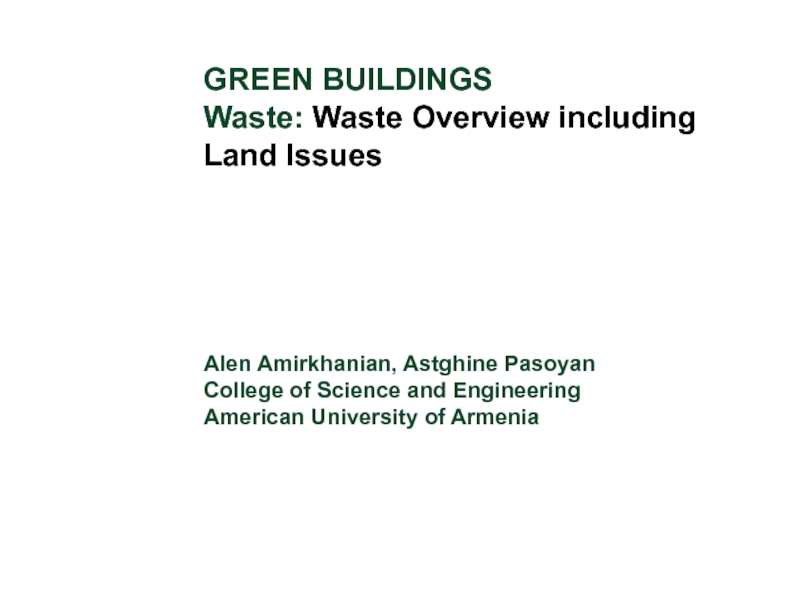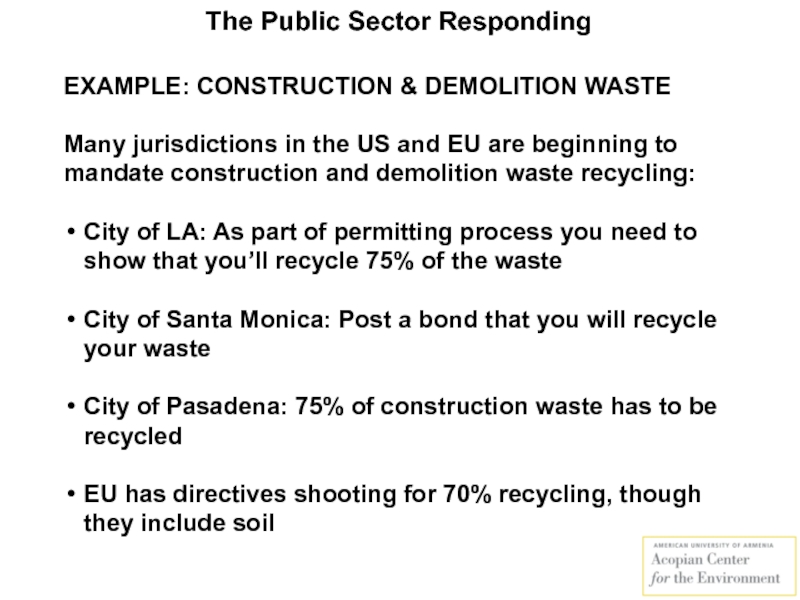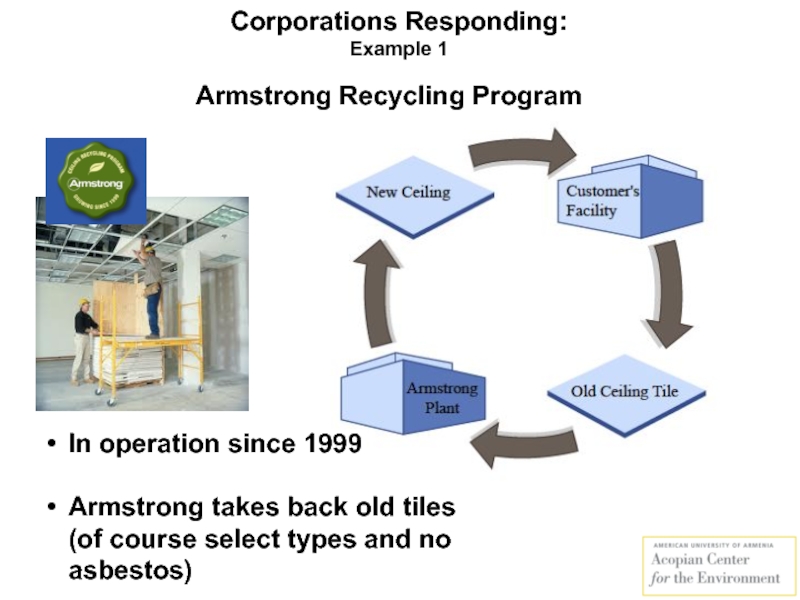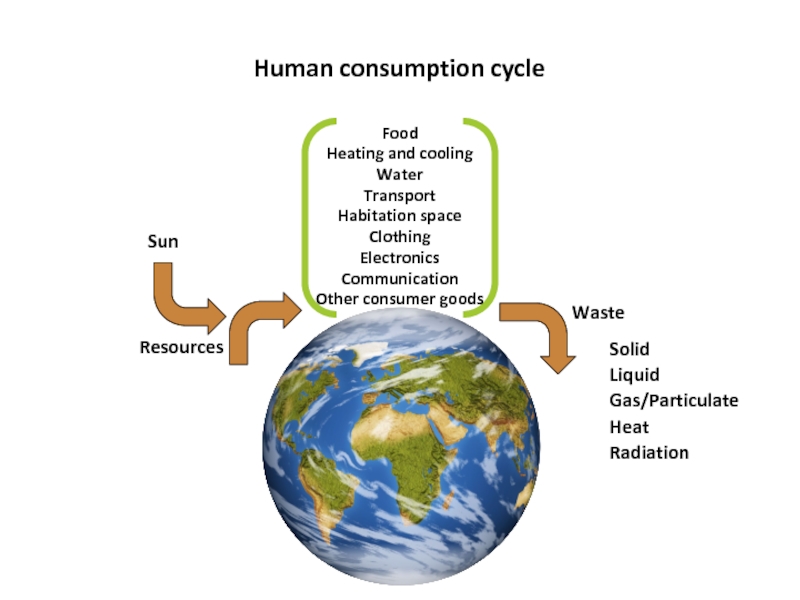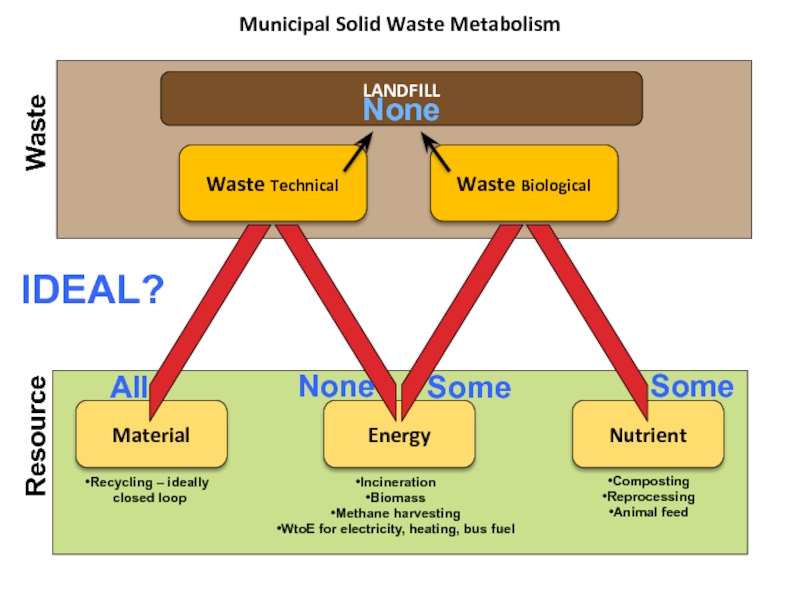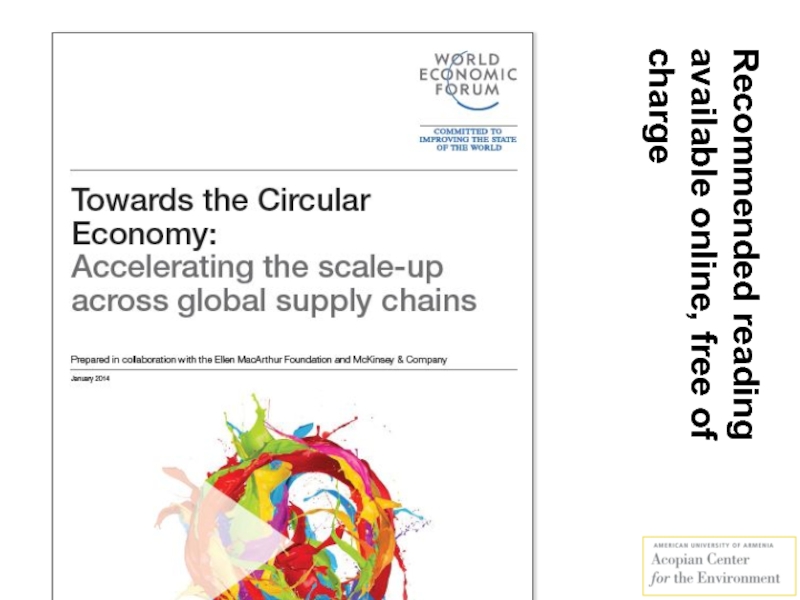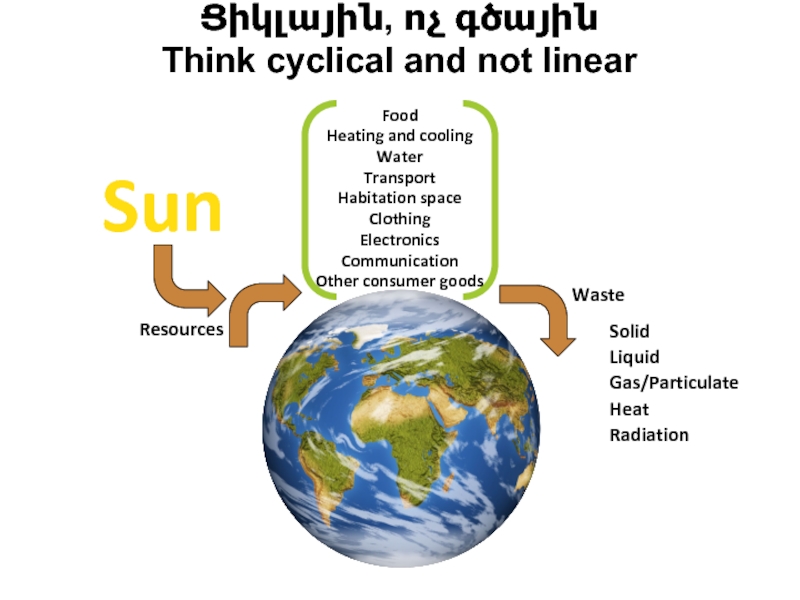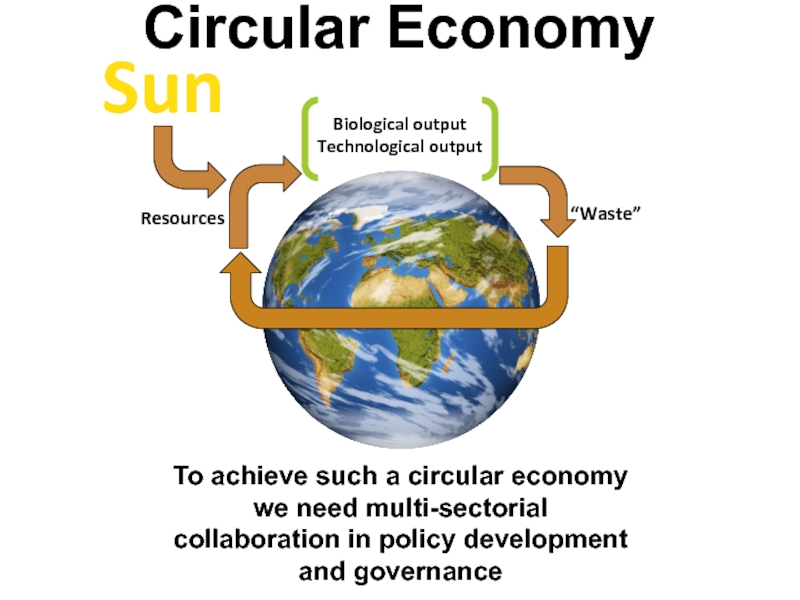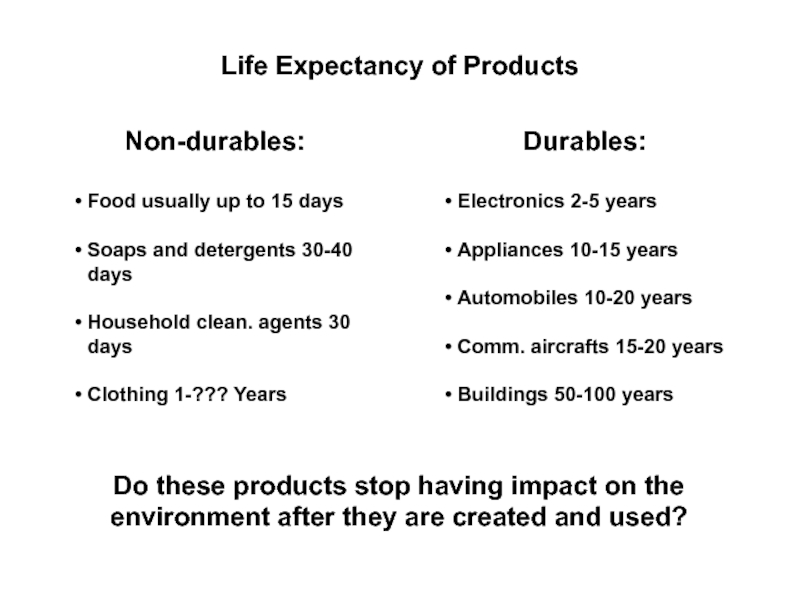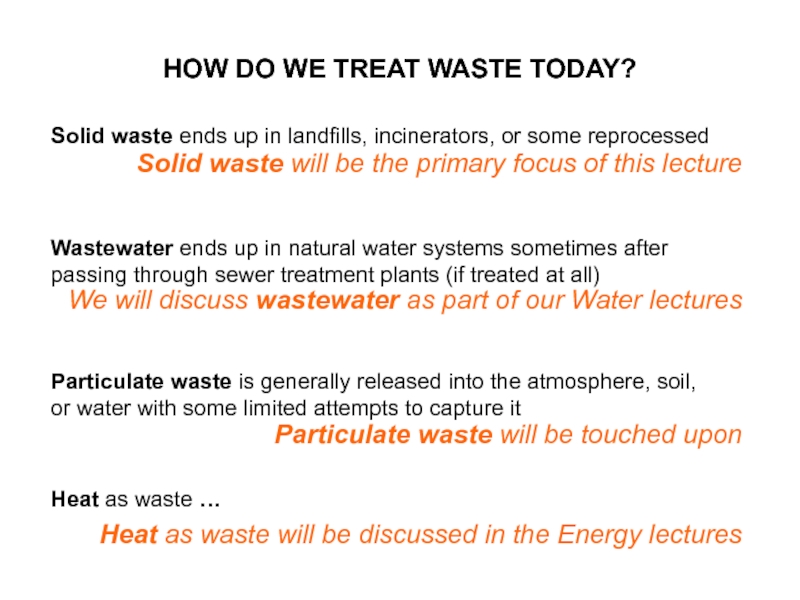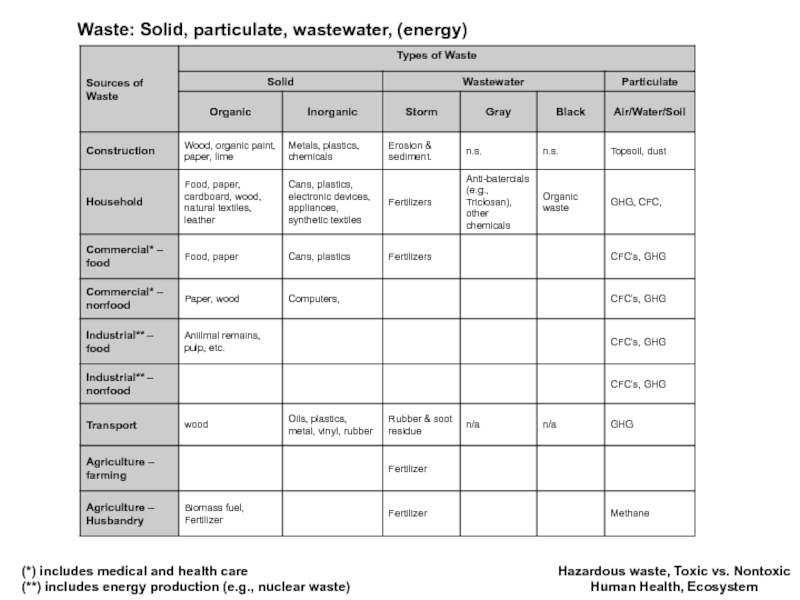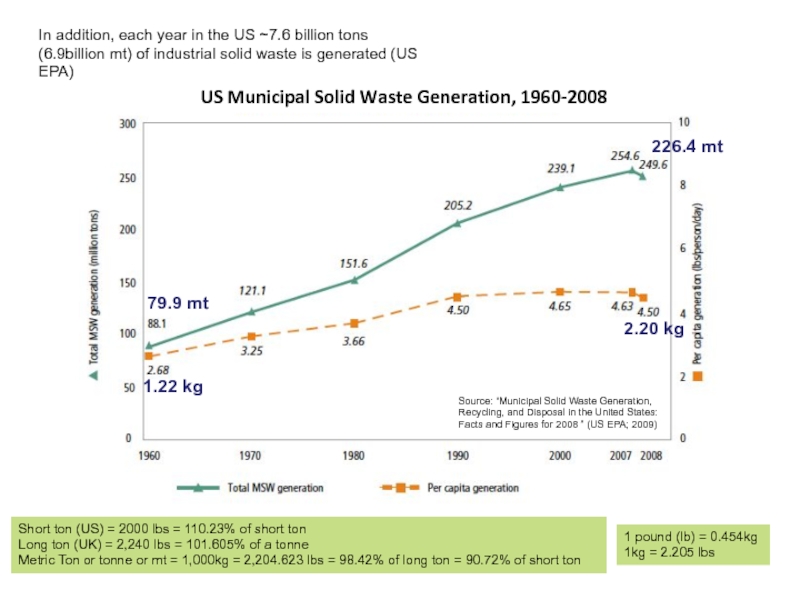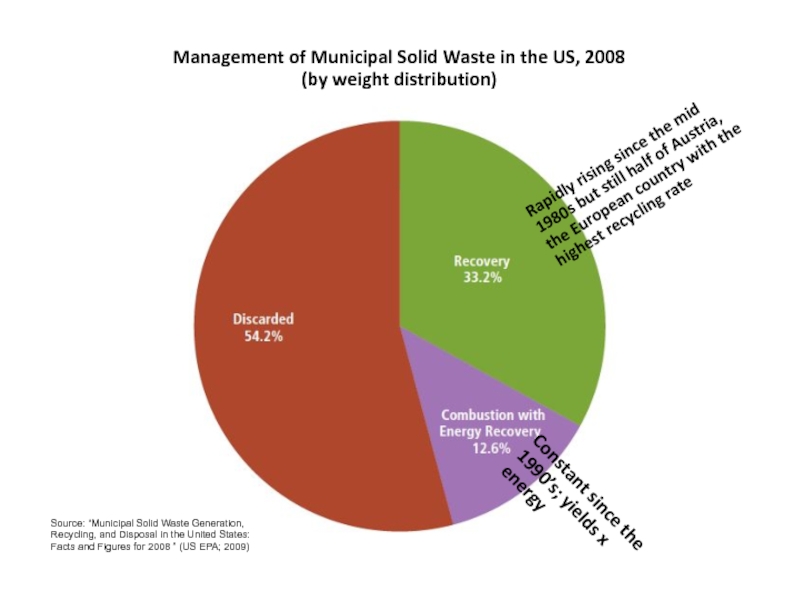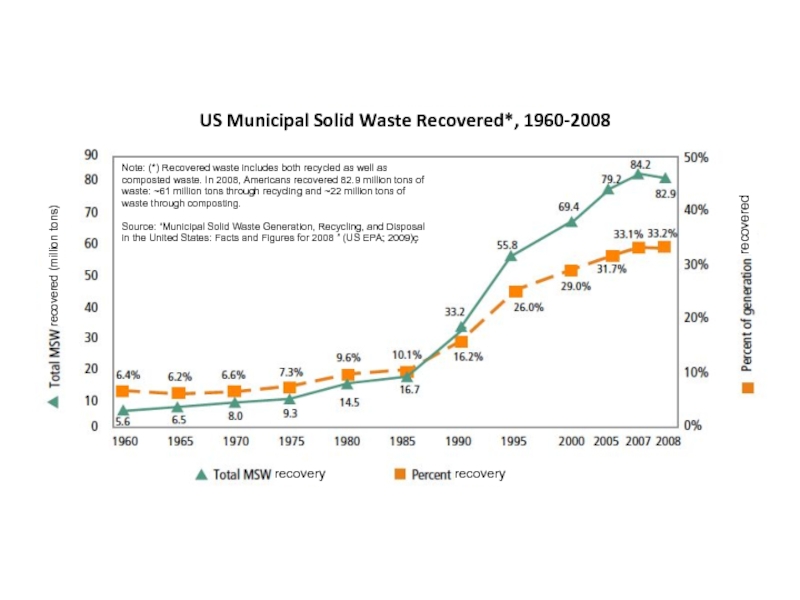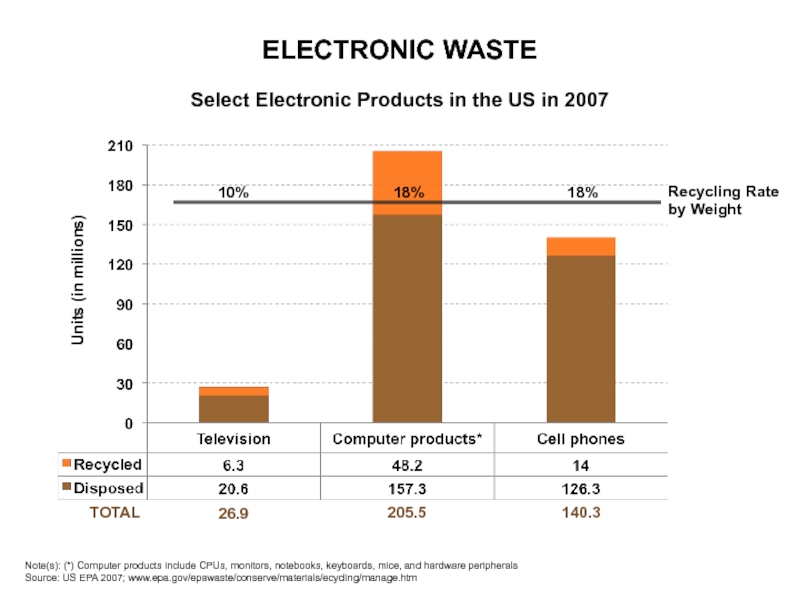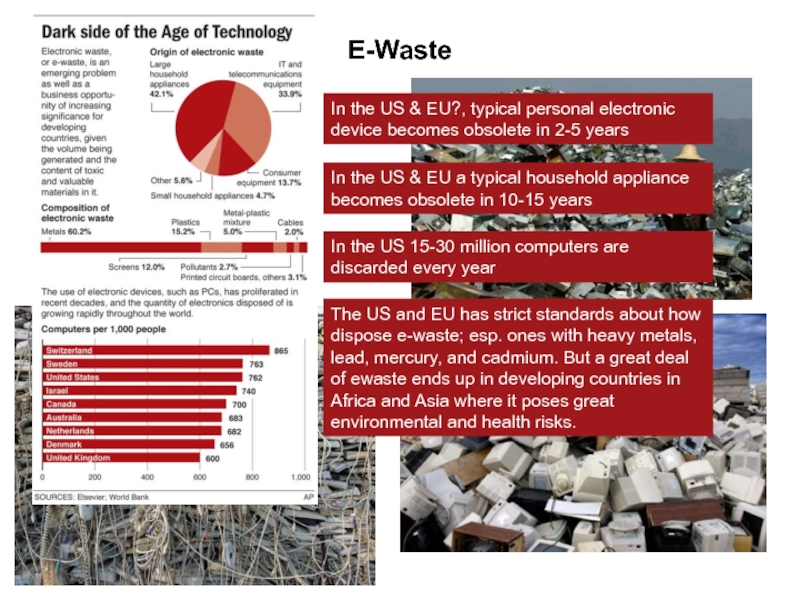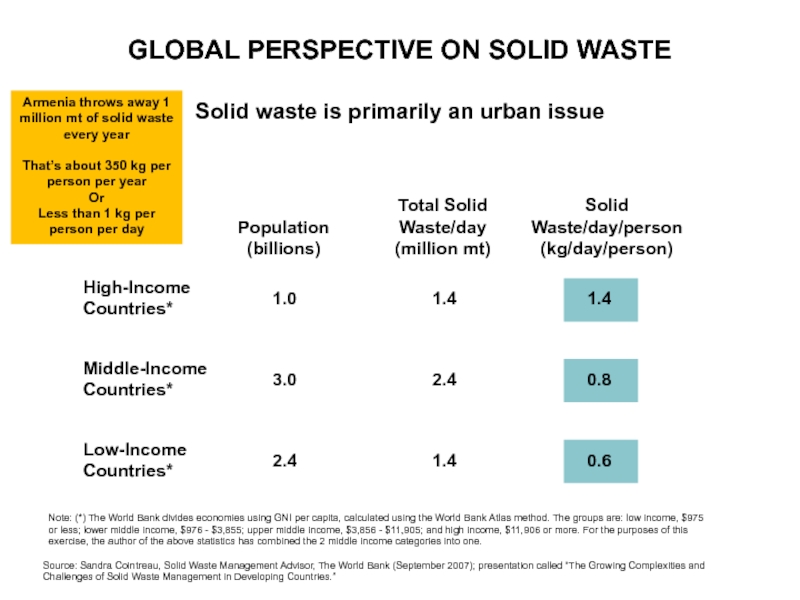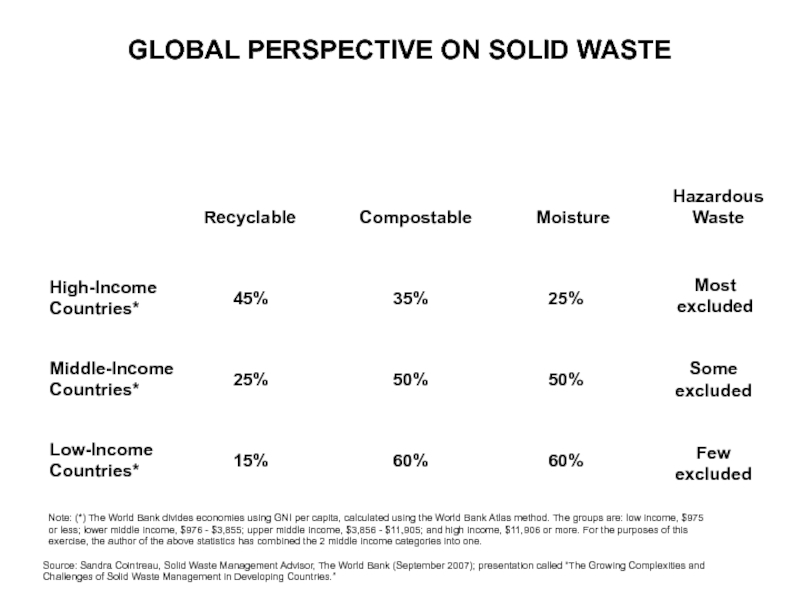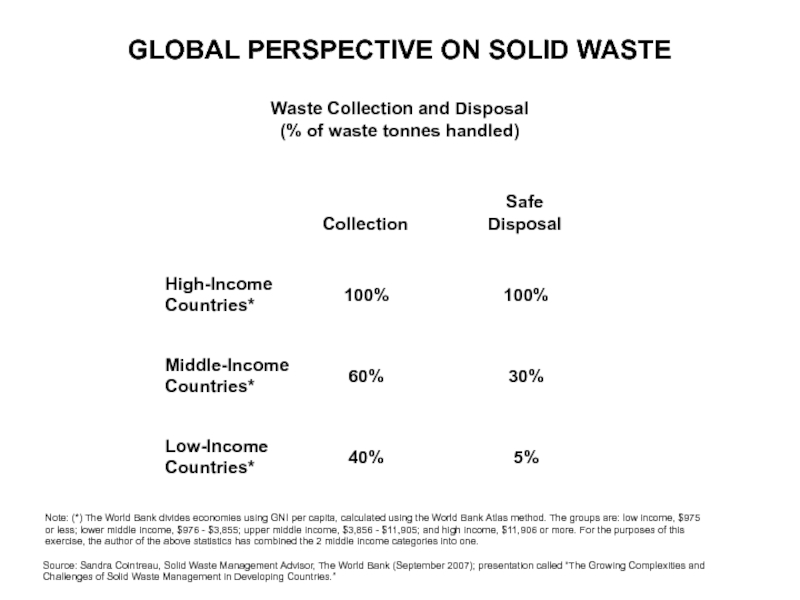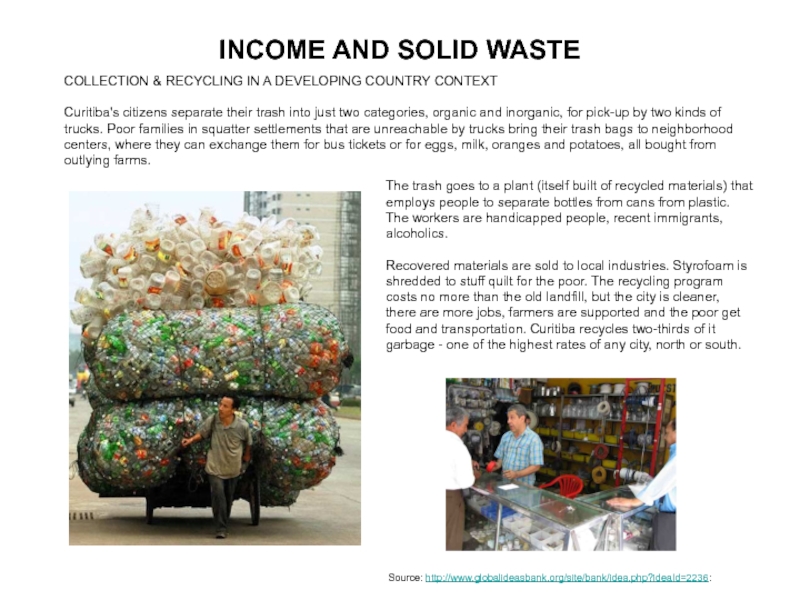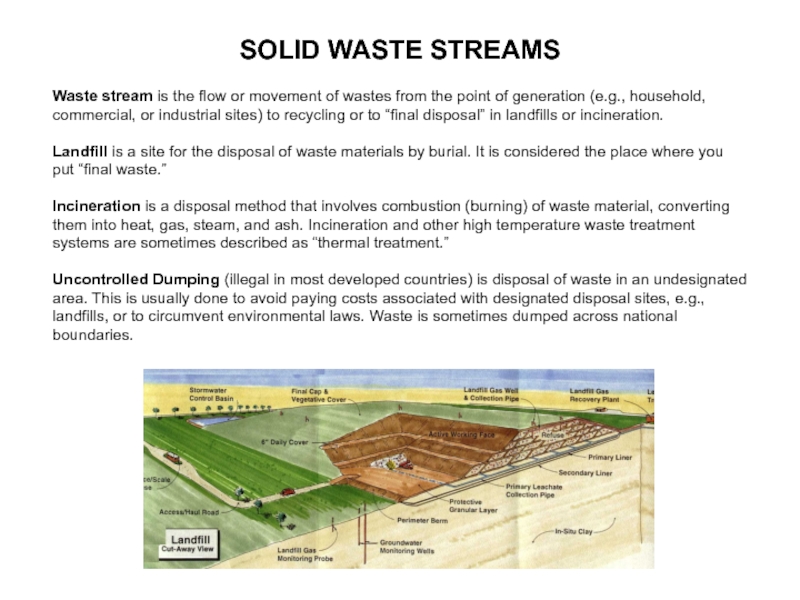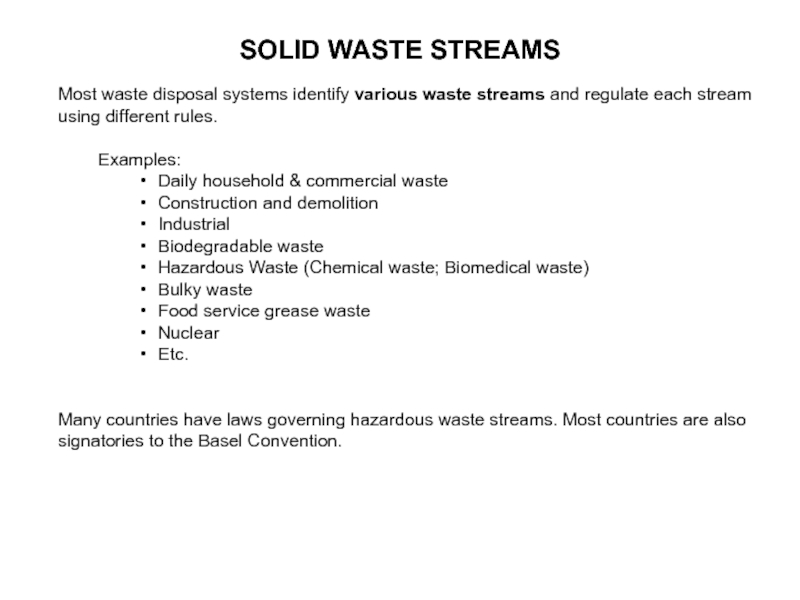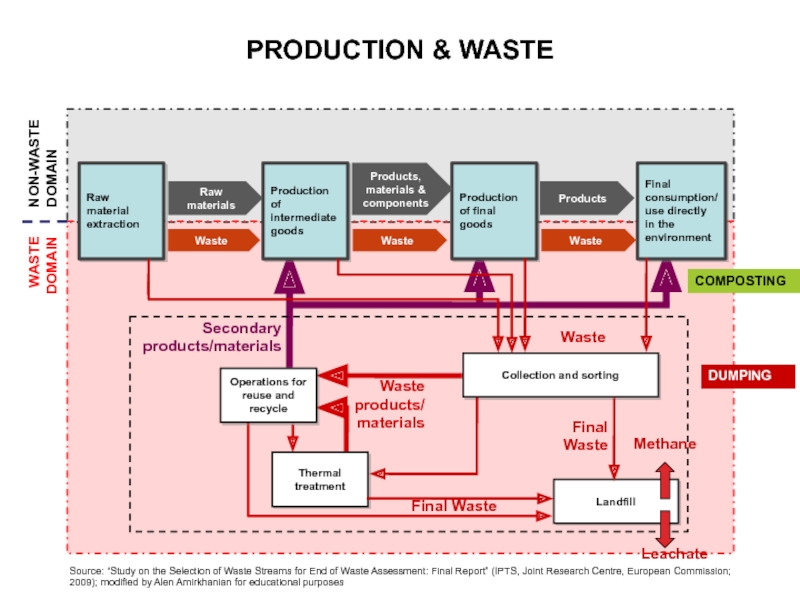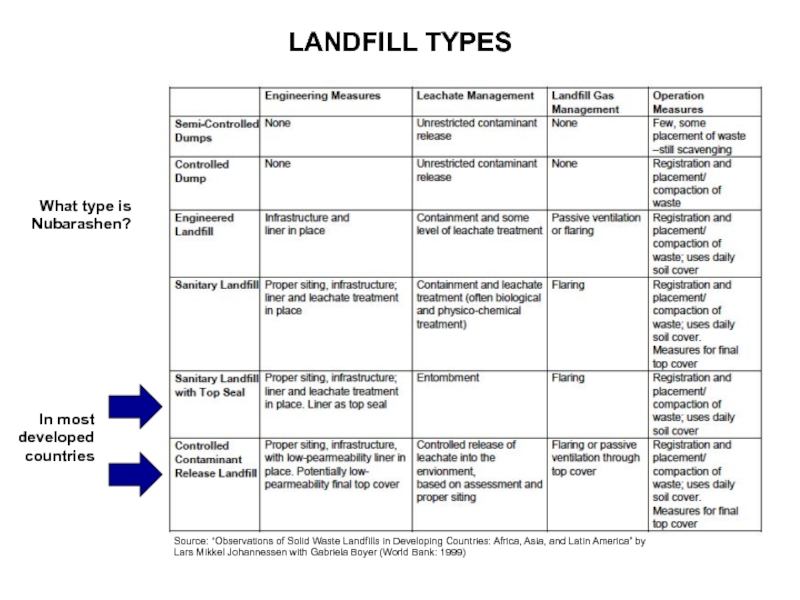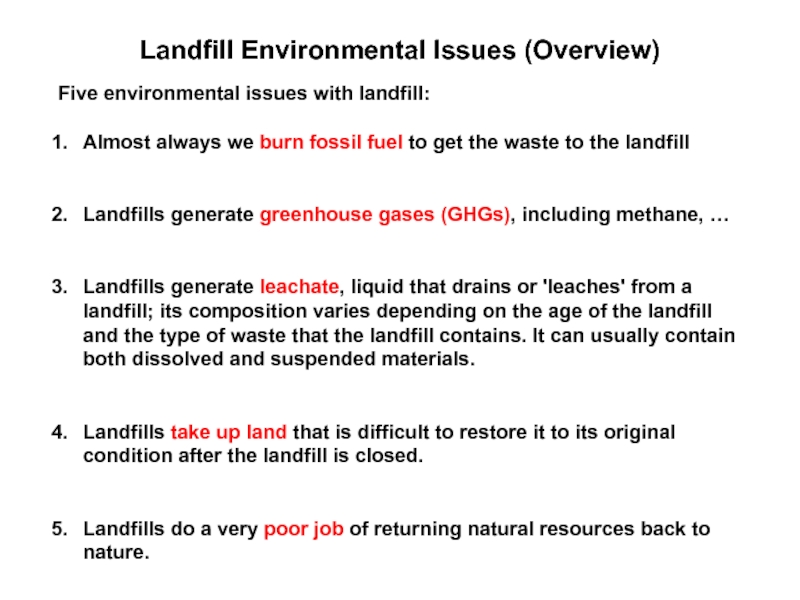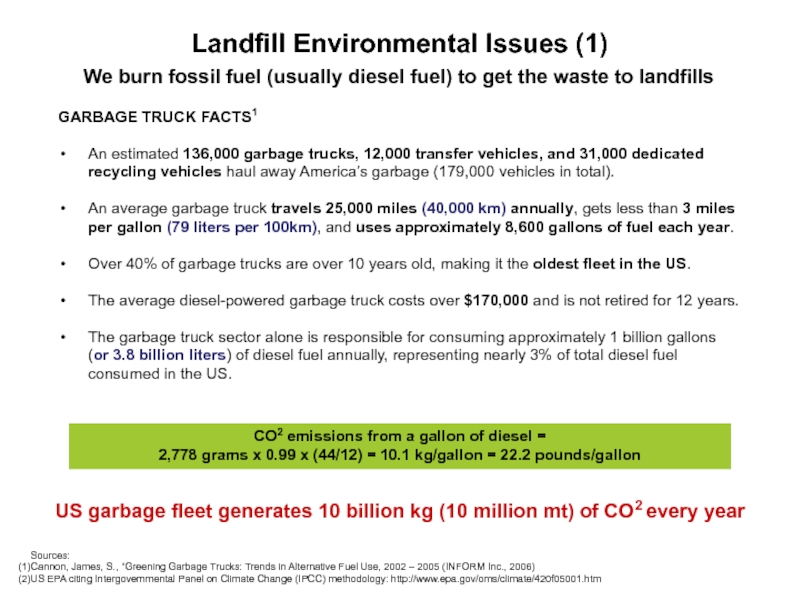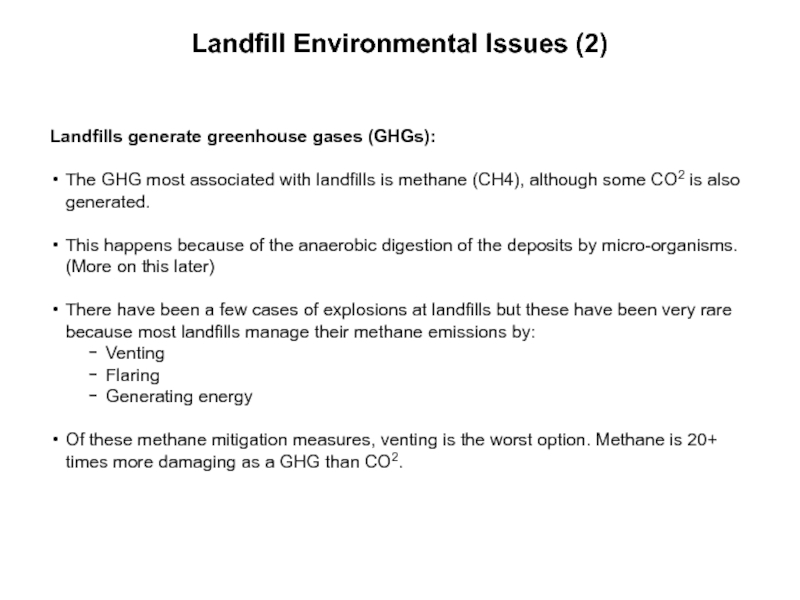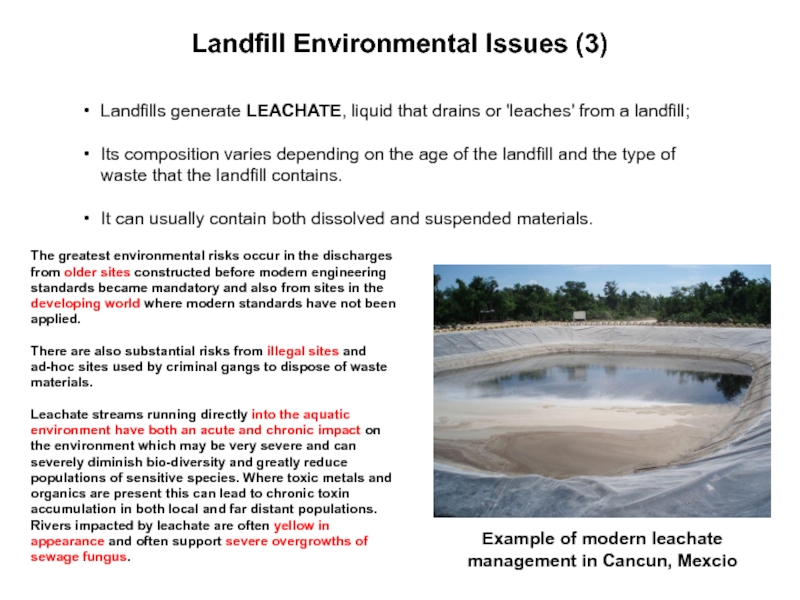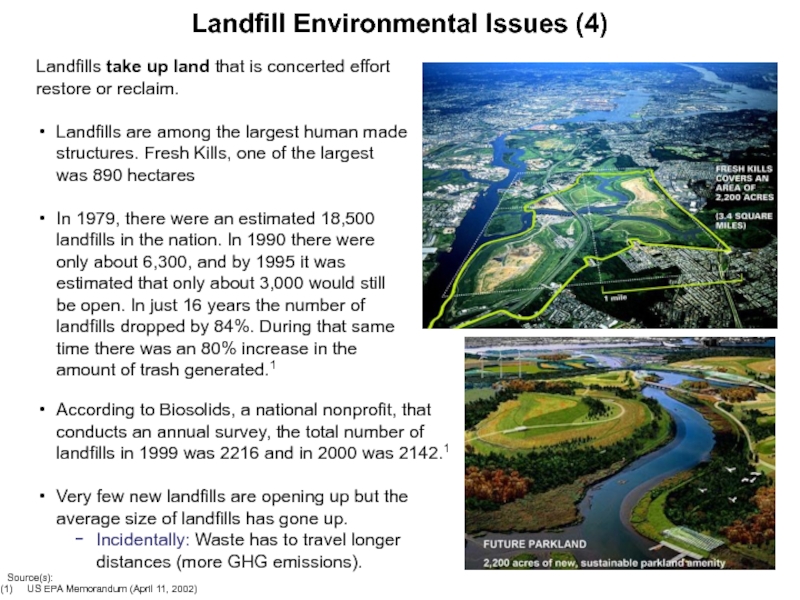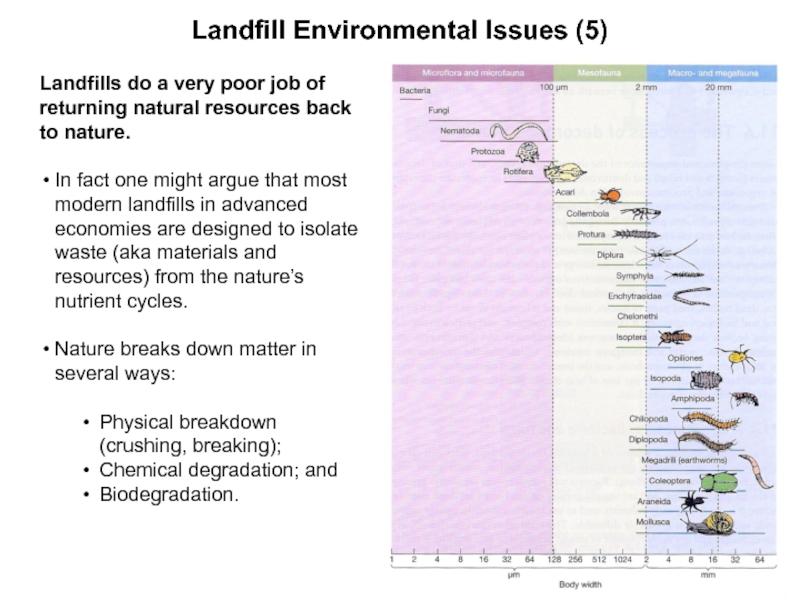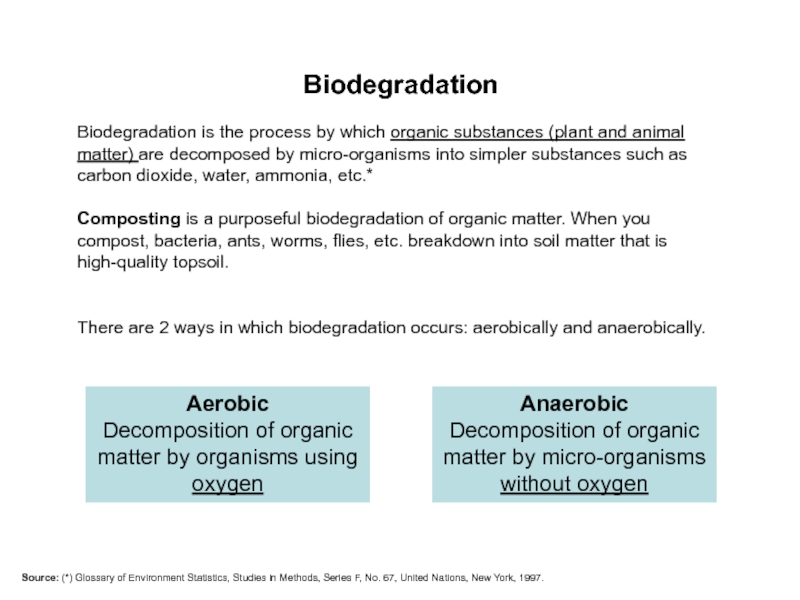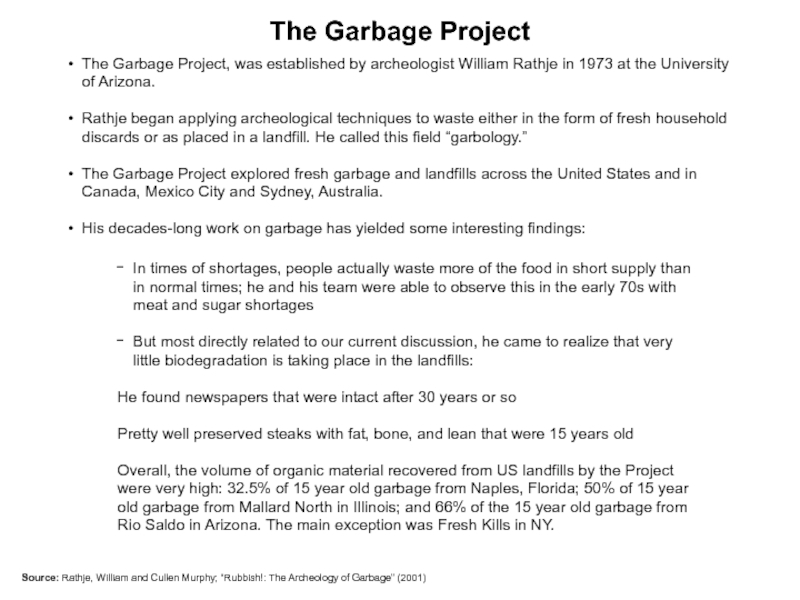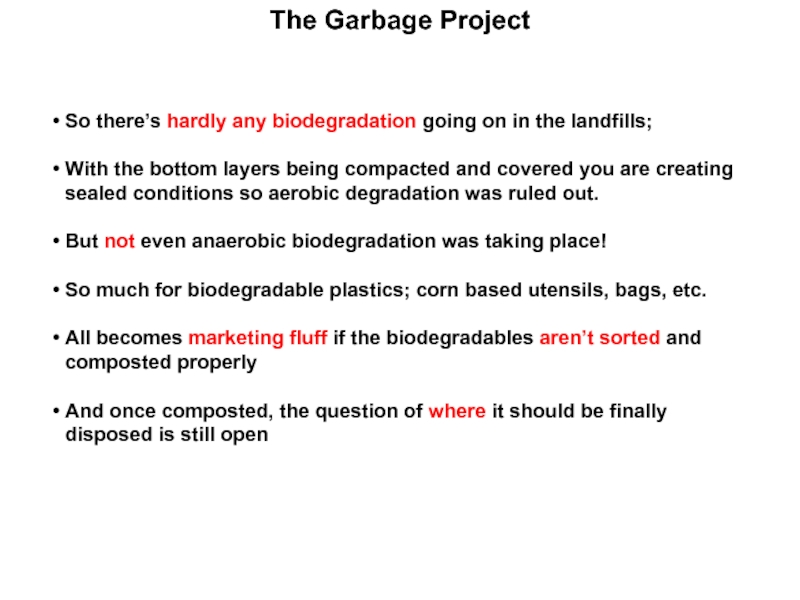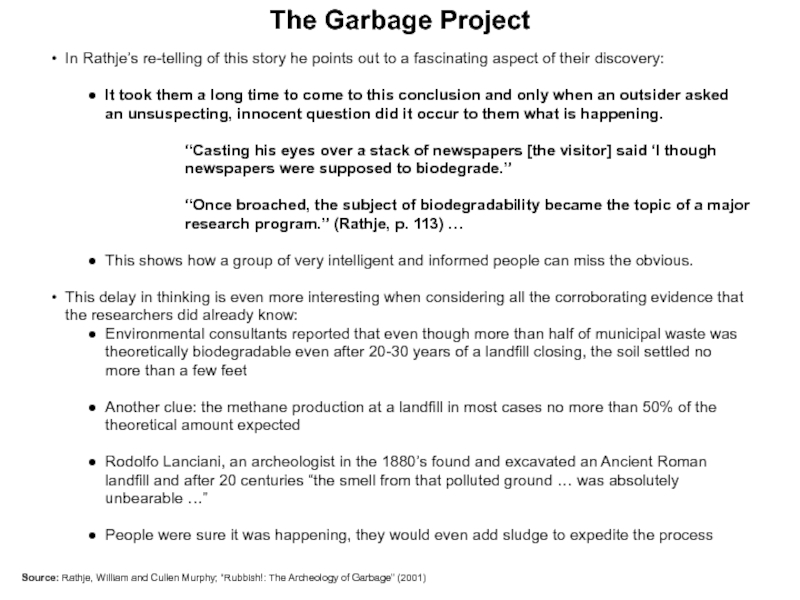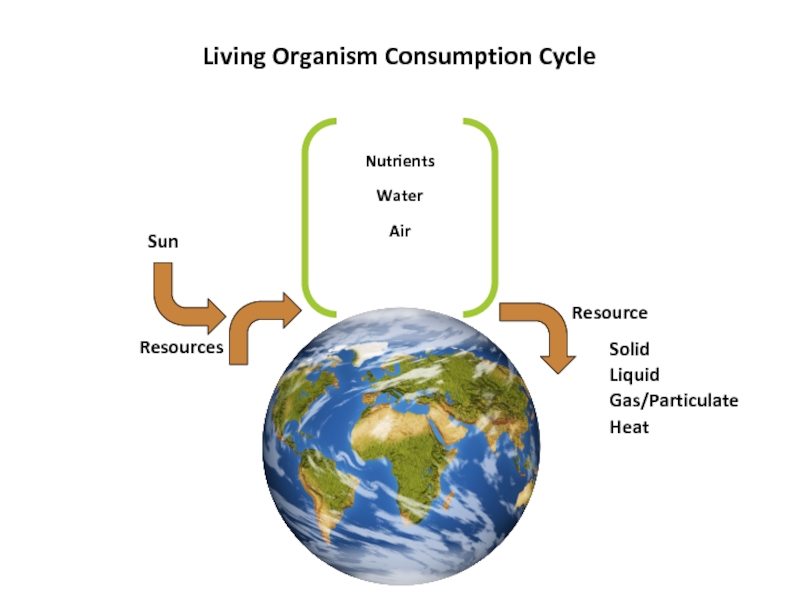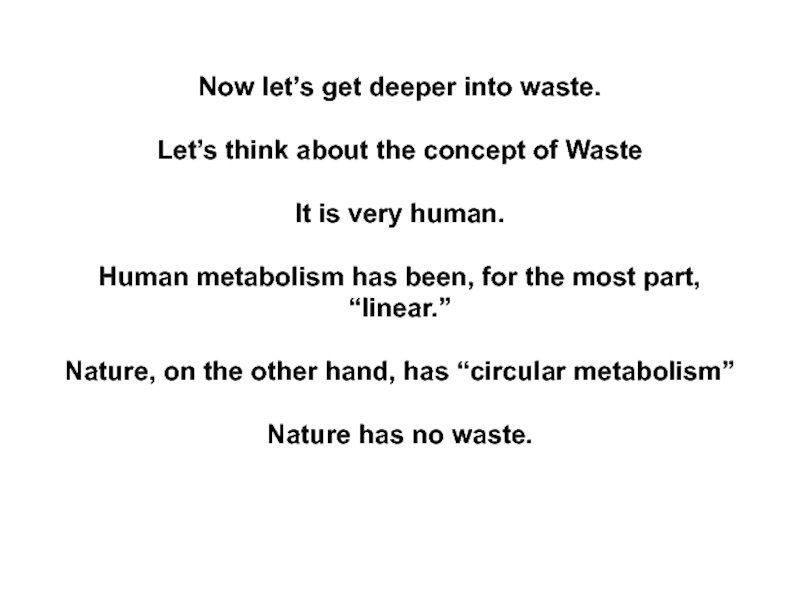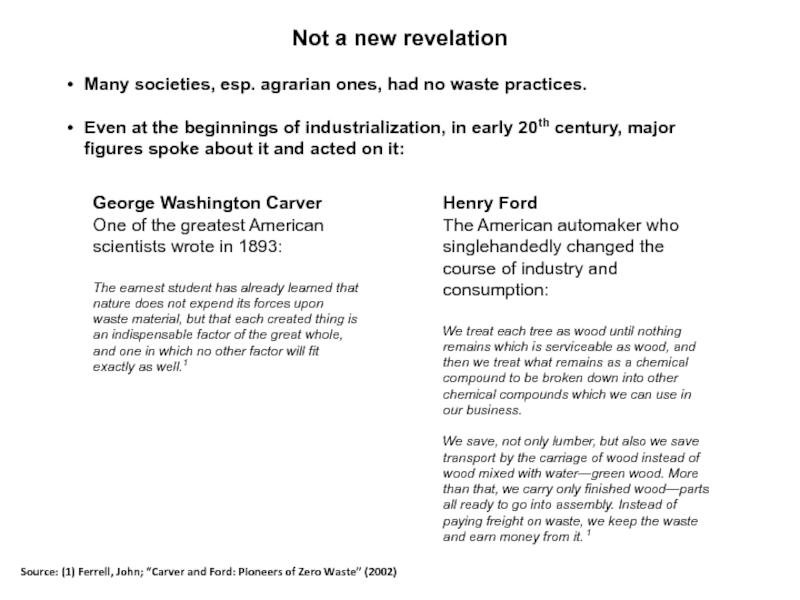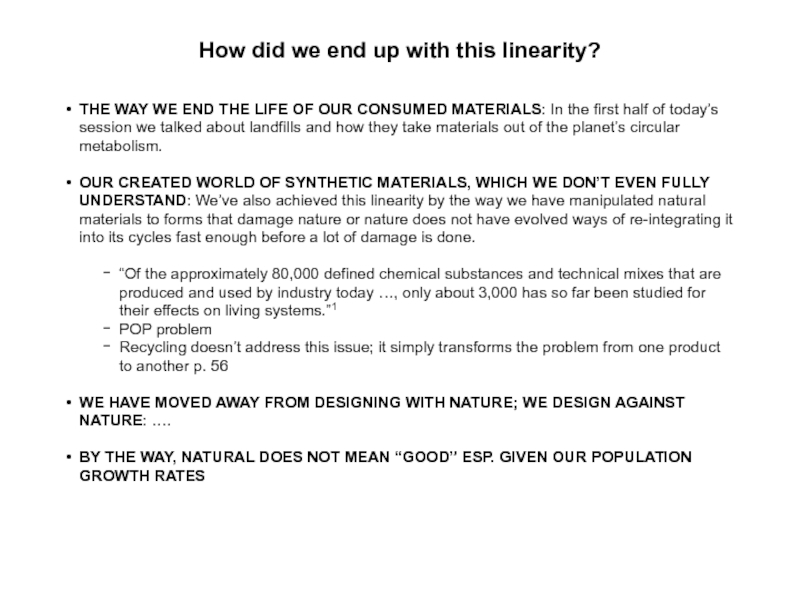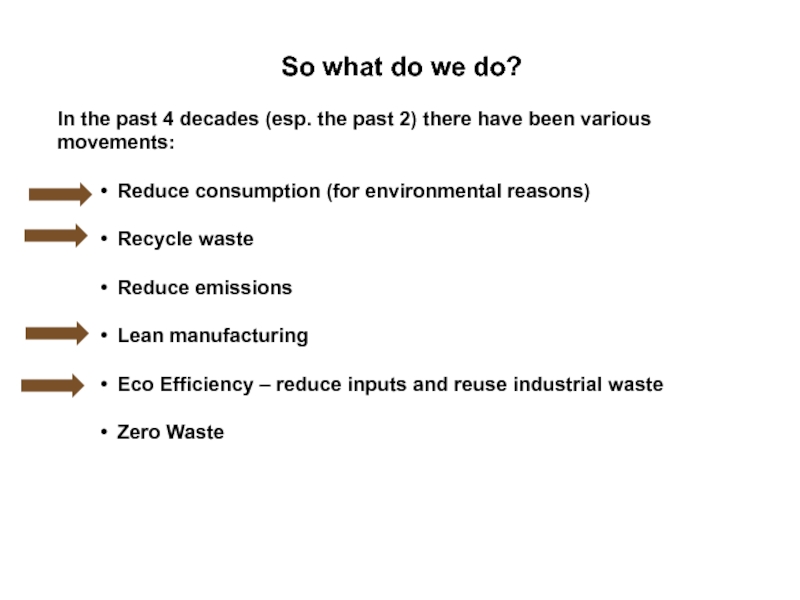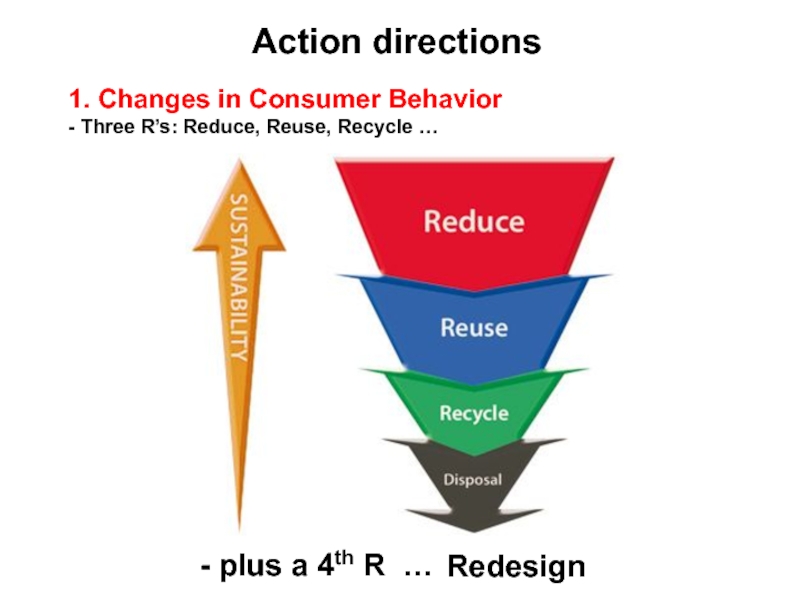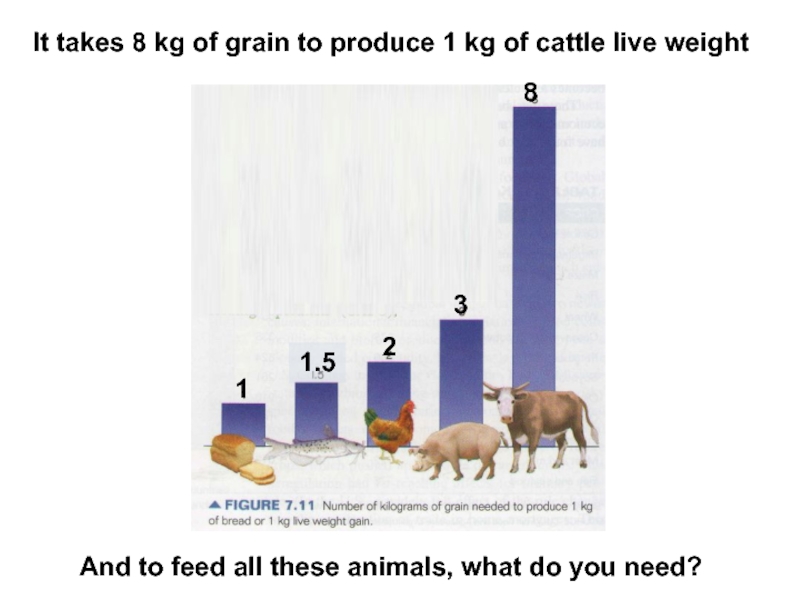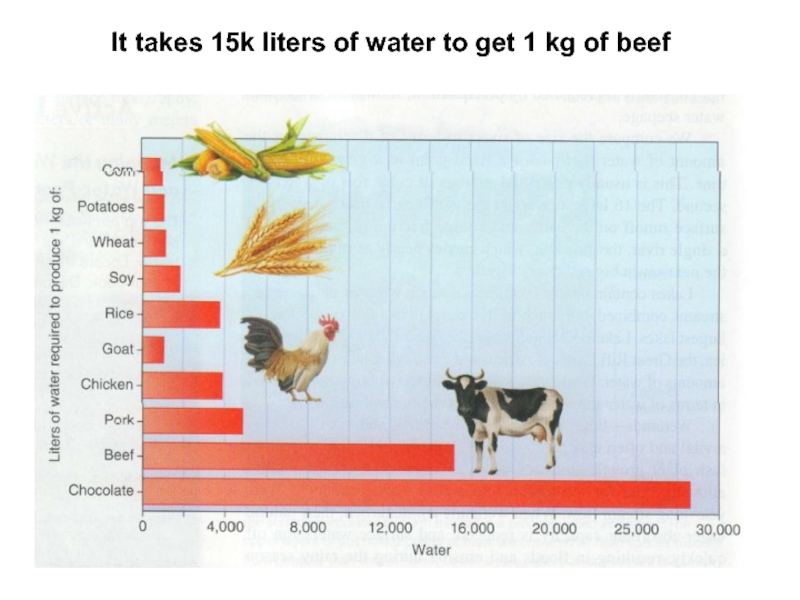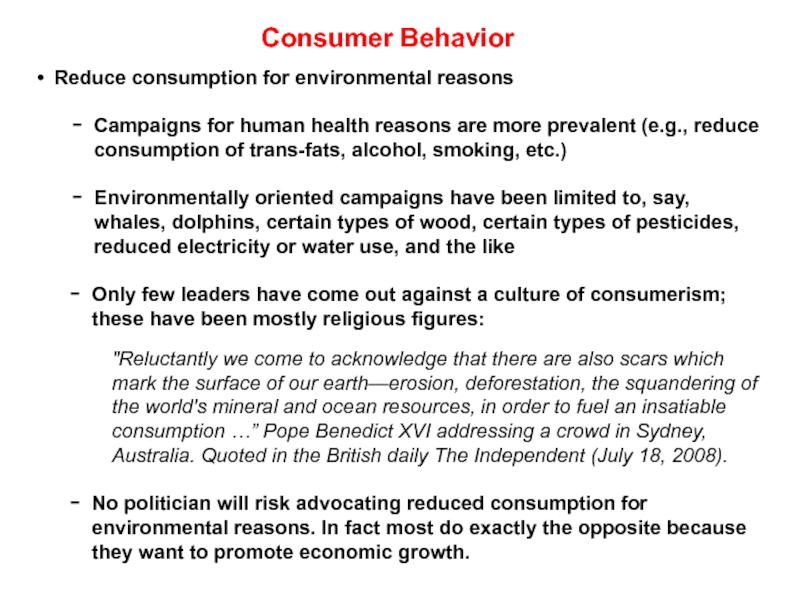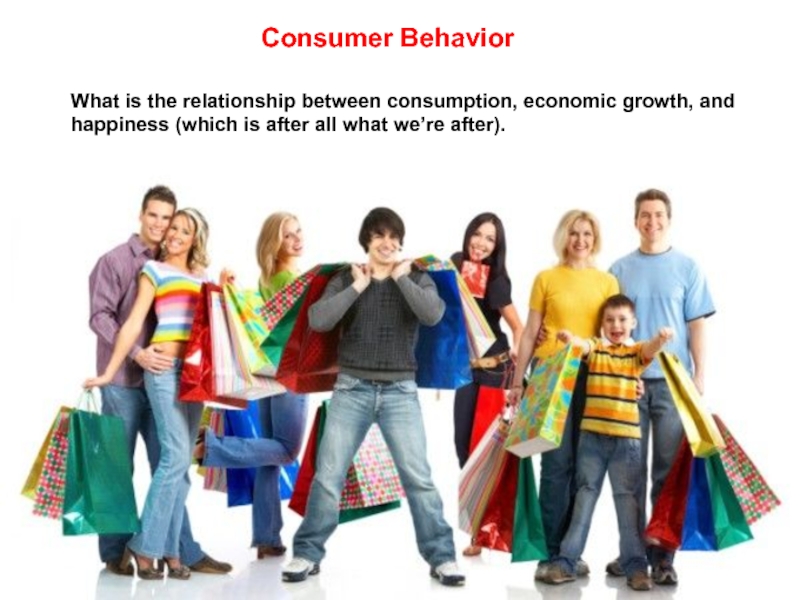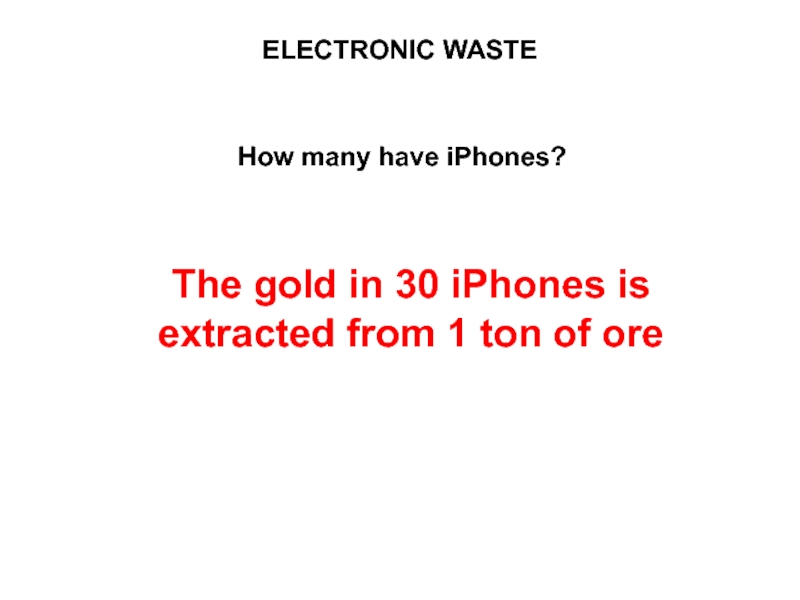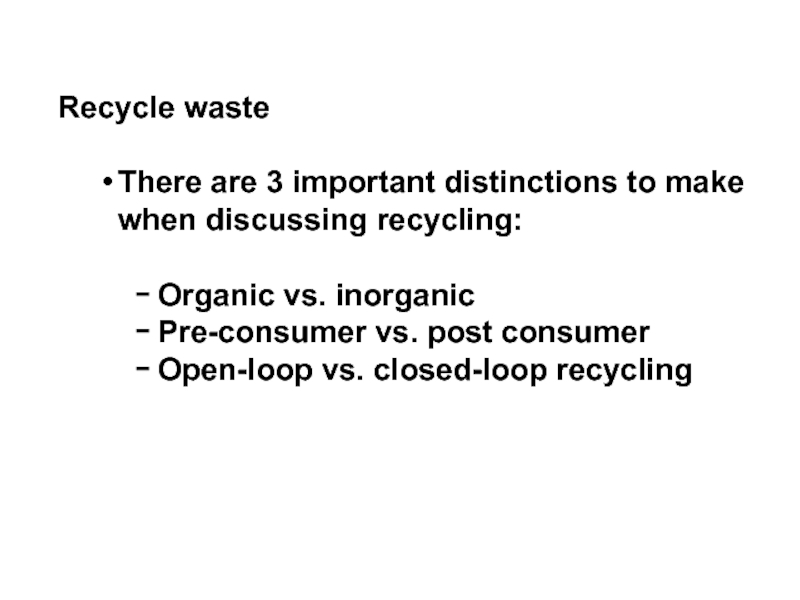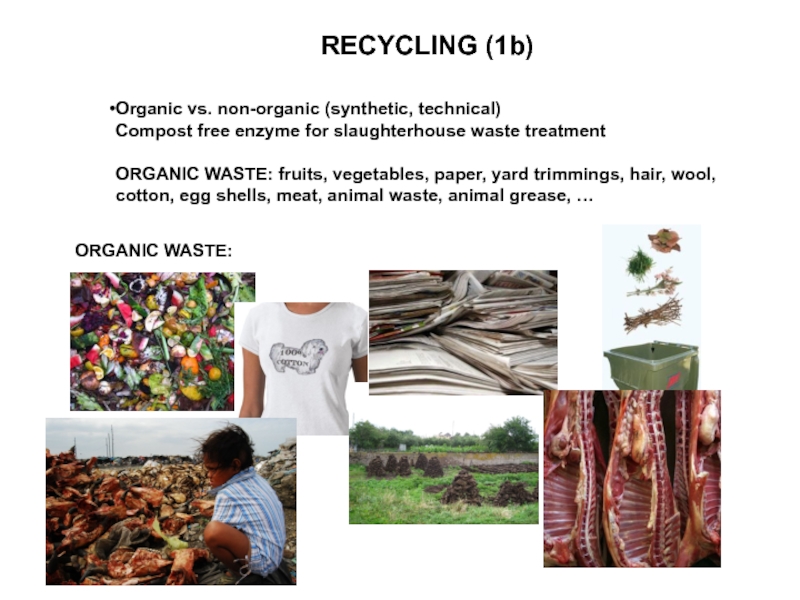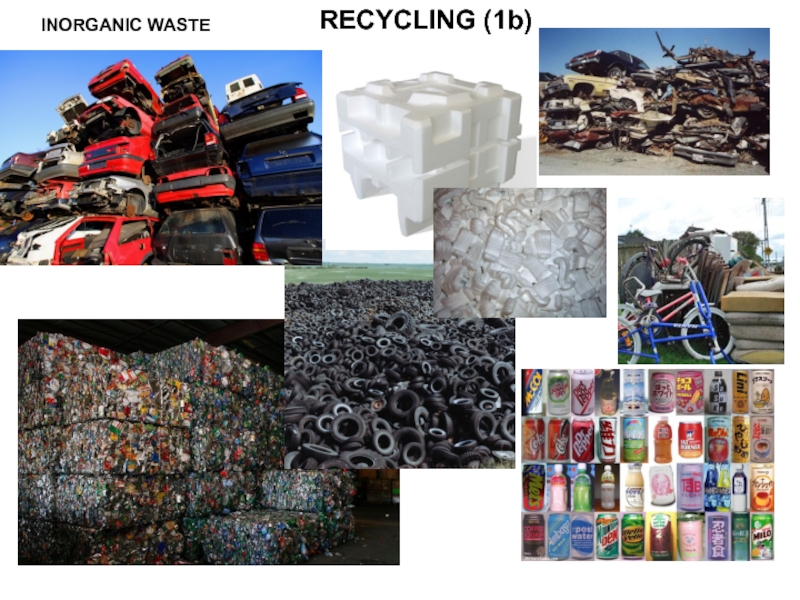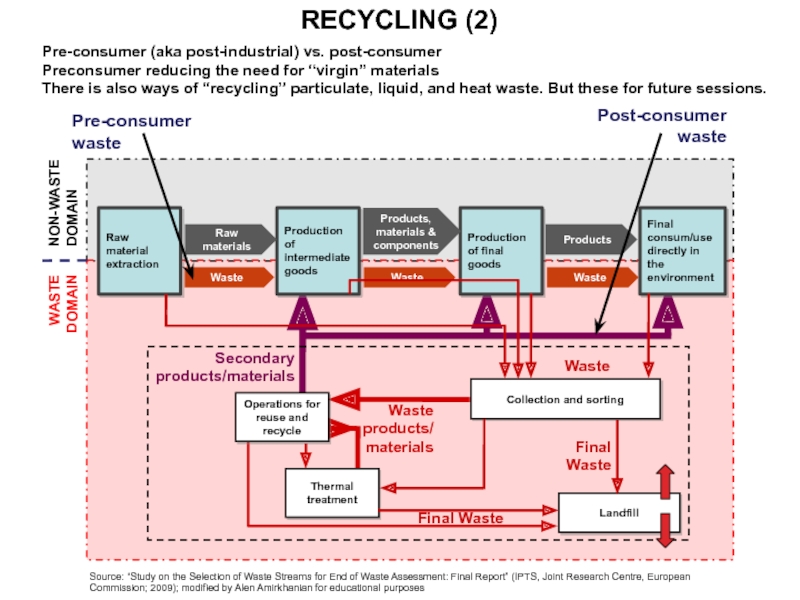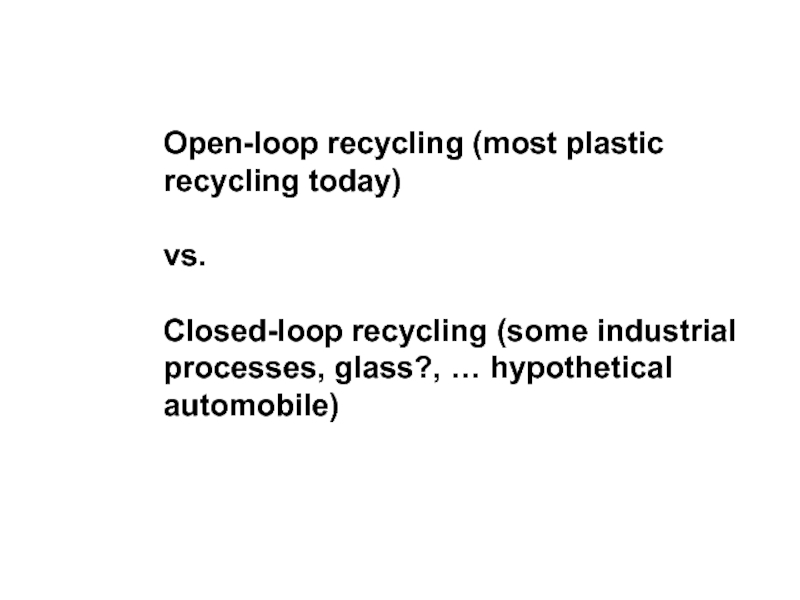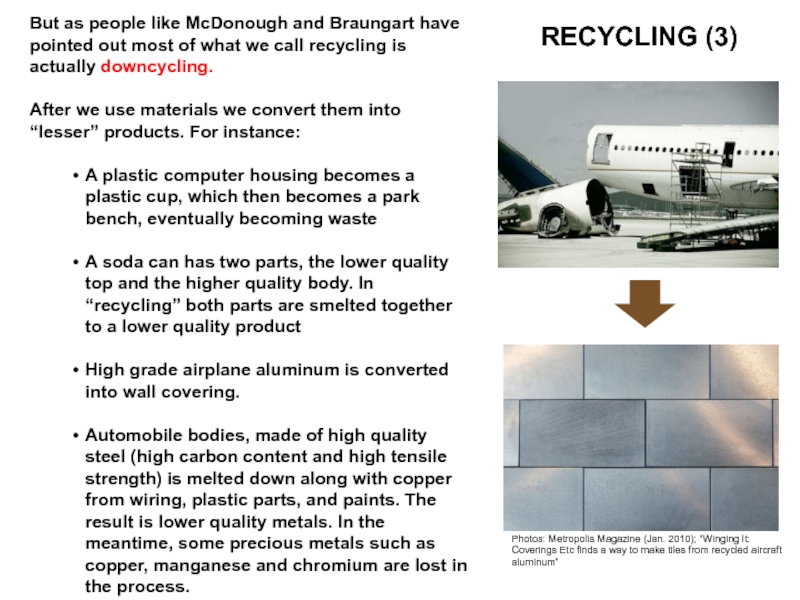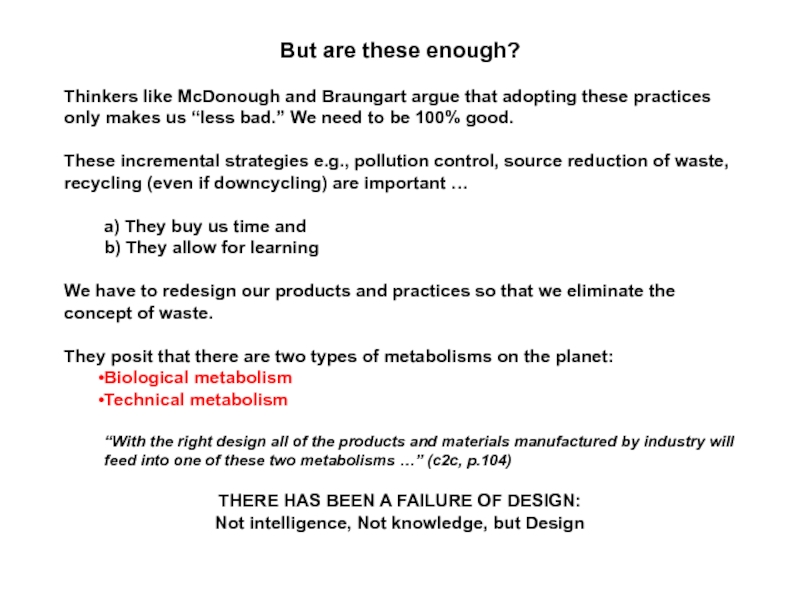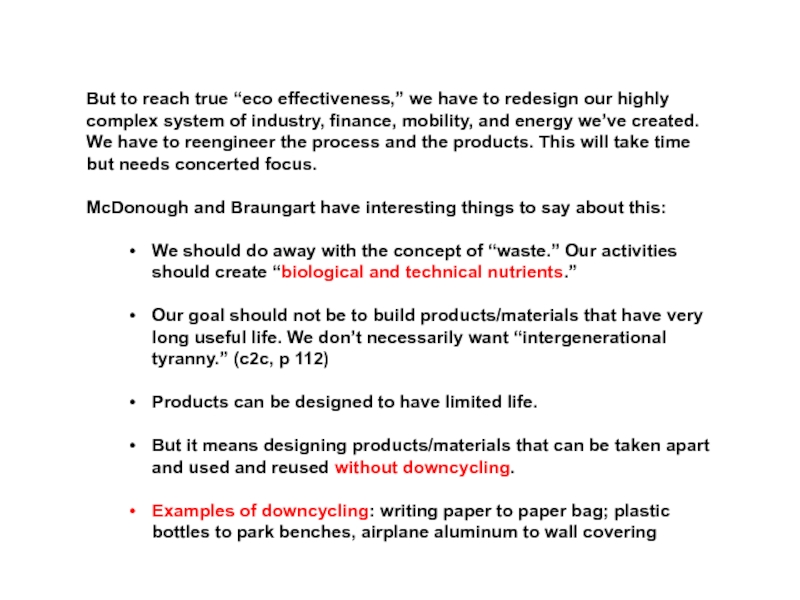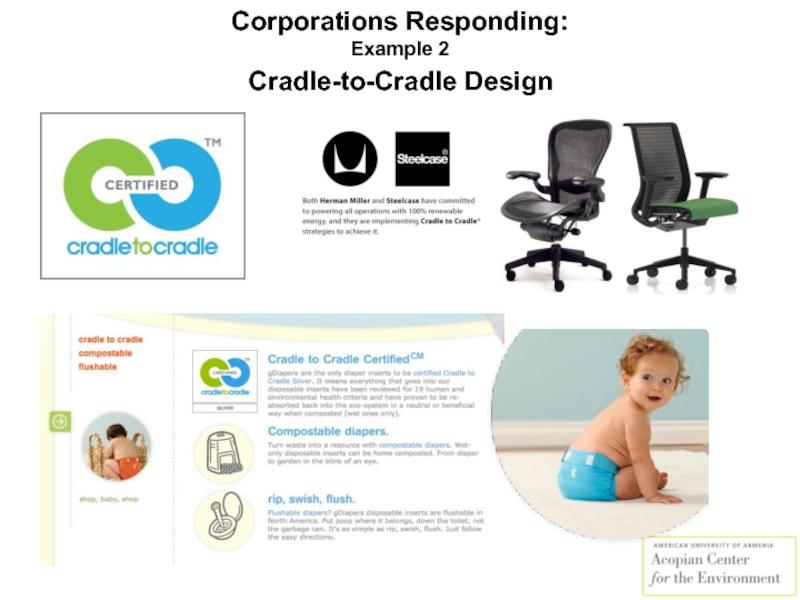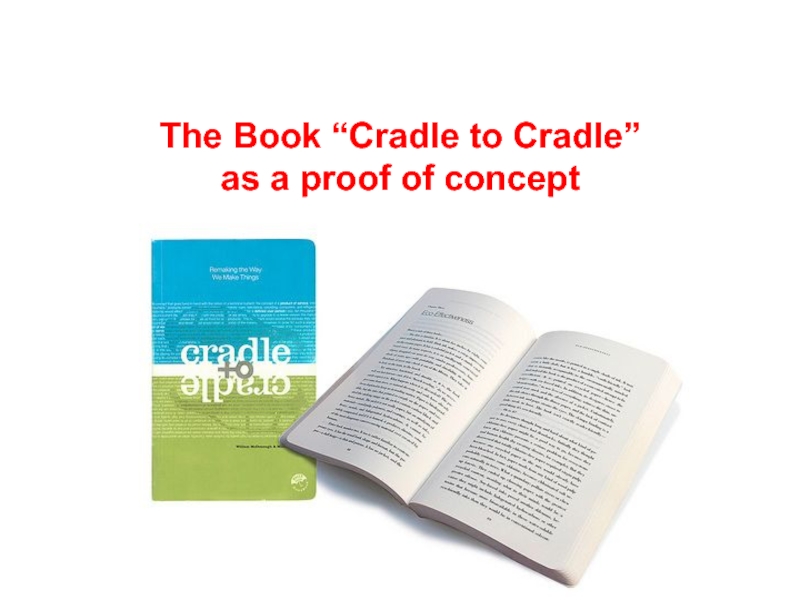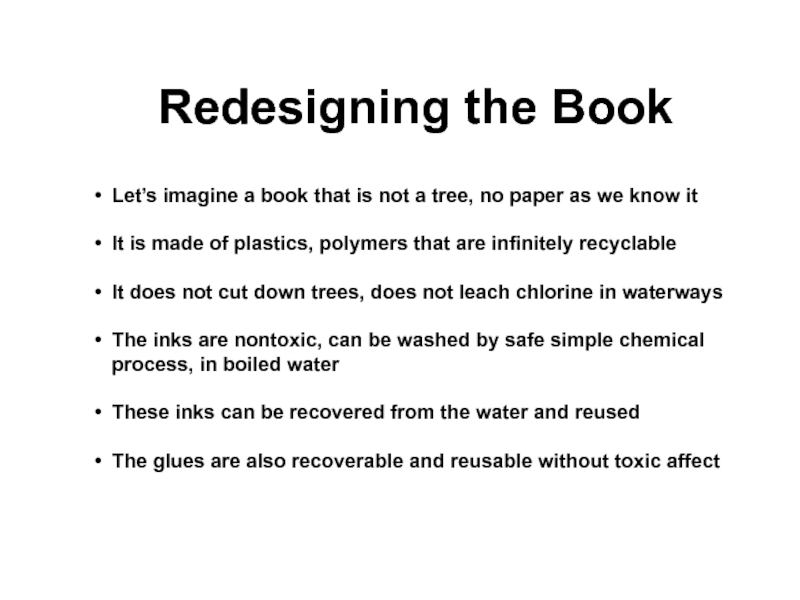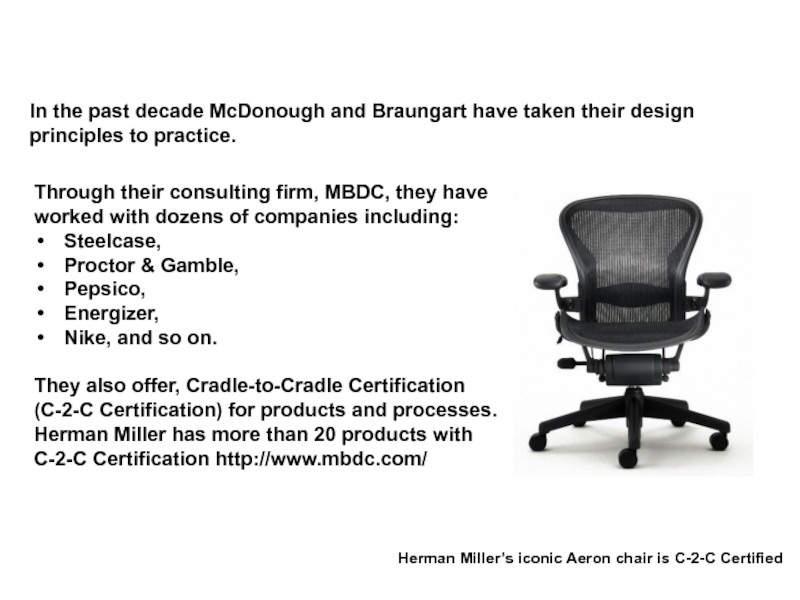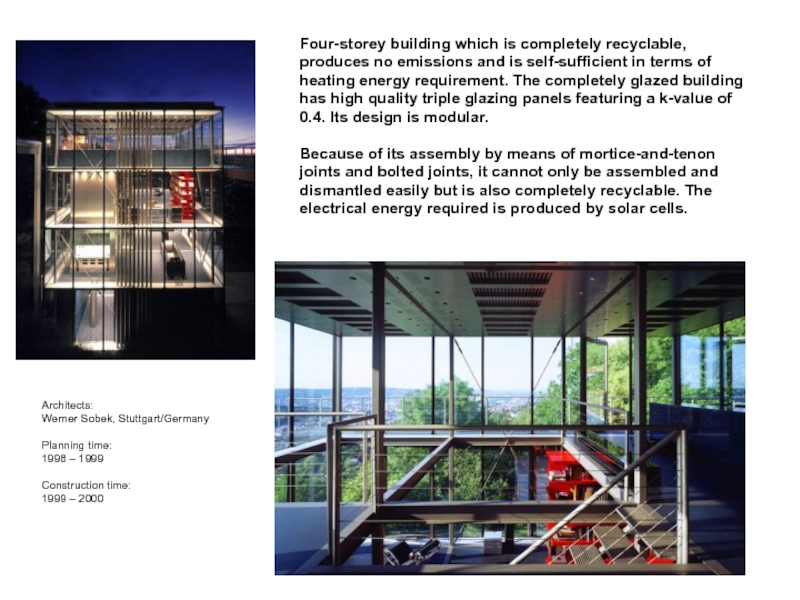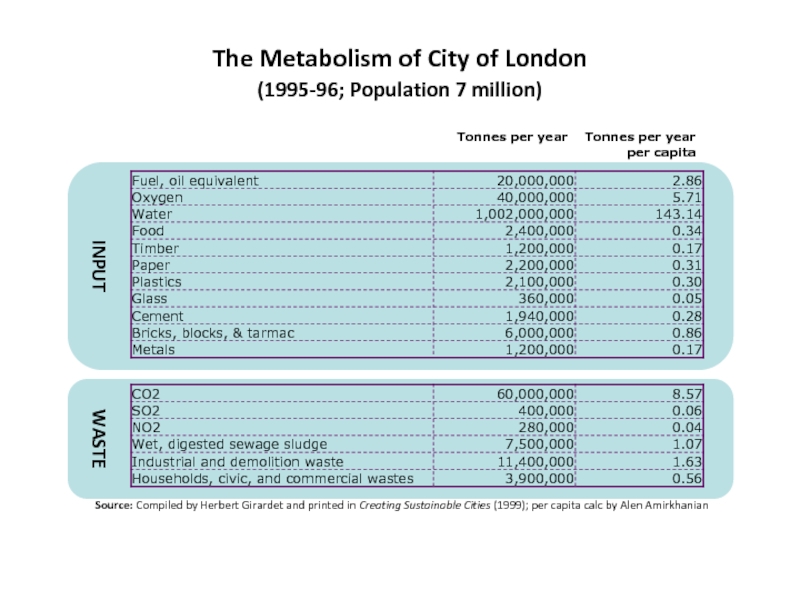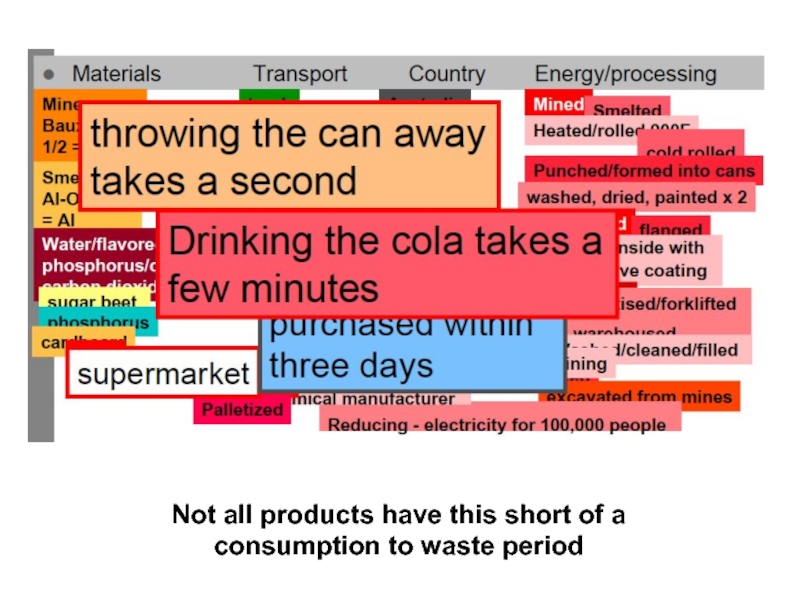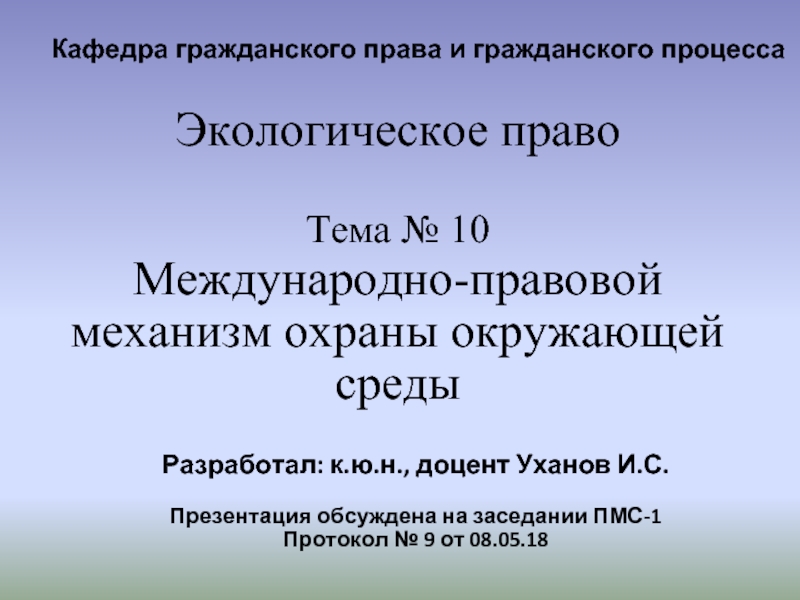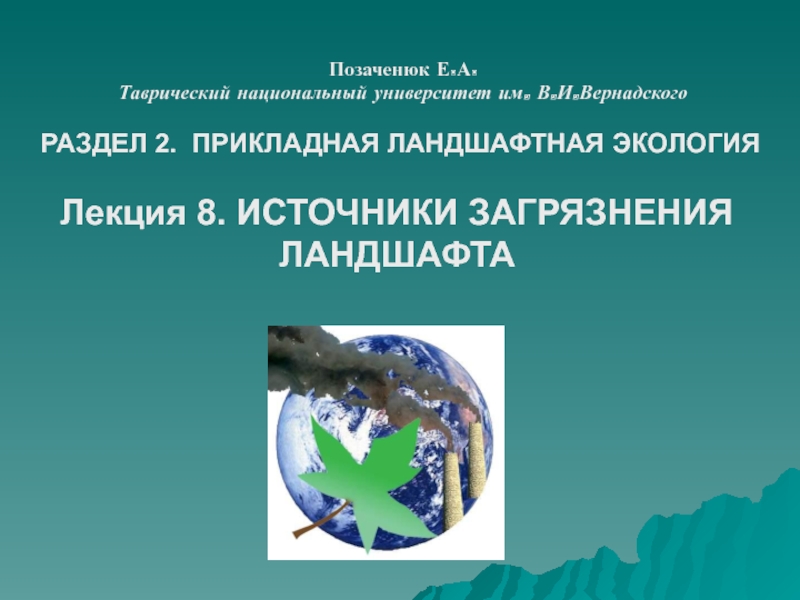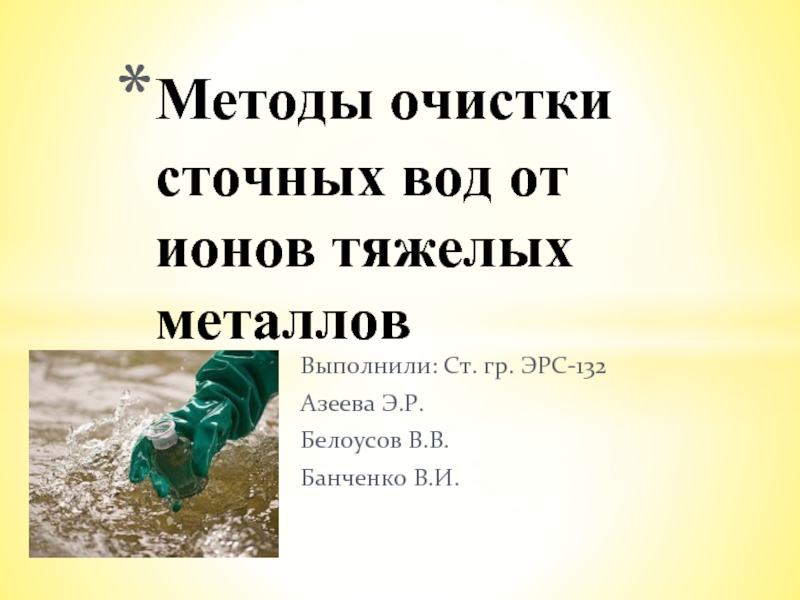- Главная
- Разное
- Дизайн
- Бизнес и предпринимательство
- Аналитика
- Образование
- Развлечения
- Красота и здоровье
- Финансы
- Государство
- Путешествия
- Спорт
- Недвижимость
- Армия
- Графика
- Культурология
- Еда и кулинария
- Лингвистика
- Английский язык
- Астрономия
- Алгебра
- Биология
- География
- Детские презентации
- Информатика
- История
- Литература
- Маркетинг
- Математика
- Медицина
- Менеджмент
- Музыка
- МХК
- Немецкий язык
- ОБЖ
- Обществознание
- Окружающий мир
- Педагогика
- Русский язык
- Технология
- Физика
- Философия
- Химия
- Шаблоны, картинки для презентаций
- Экология
- Экономика
- Юриспруденция
Green buildings waste: waste overview including land issues презентация
Содержание
- 1. Green buildings waste: waste overview including land issues
- 2. EXAMPLE: CONSTRUCTION & DEMOLITION WASTE Many
- 3. Corporations Responding: Example 1 In
- 4. Food Water Habitation space Transport Heating and
- 5. Waste Metabolism Waste
- 6. Municipal Solid Waste Metabolism Waste Technical Waste Biological Waste IDEAL?
- 7. Resources Sun Recommended reading available online, free of charge
- 8. Food Water Habitation space Transport Heating and
- 9. Biological output Technological output “Waste” Circular Economy
- 10. Electronics 2-5 years Appliances 10-15 years
- 11. Heat as waste … Solid waste will
- 12. Waste: Solid, particulate, wastewater, (energy) Hazardous waste,
- 13. Short ton (US) = 2000 lbs =
- 14. Management of Municipal Solid Waste in the
- 16. Source: “Municipal Solid Waste Generation, Recycling, and
- 17. ELECTRONIC WASTE Select Electronic Products in the
- 18. E-Waste
- 19. GLOBAL PERSPECTIVE ON SOLID WASTE Solid waste
- 20. GLOBAL PERSPECTIVE ON SOLID WASTE Recyclable Compostable
- 21. GLOBAL PERSPECTIVE ON SOLID WASTE Waste Collection
- 22. INCOME AND SOLID WASTE The trash goes
- 23. SOLID WASTE STREAMS Waste stream is the
- 24. SOLID WASTE STREAMS Most waste disposal systems
- 25. Source: “Study on the Selection of Waste
- 26. Source: “Observations of Solid Waste Landfills in
- 27. Landfill Environmental Issues (Overview) Five environmental issues
- 28. Landfill Environmental Issues (1) We burn fossil
- 29. Landfills generate greenhouse gases (GHGs):
- 30. Landfills generate LEACHATE, liquid that drains or
- 31. According to Biosolids, a national nonprofit,
- 32. Landfill Environmental Issues (5) Landfills do a
- 33. Biodegradation Biodegradation is the process by
- 34. The Garbage Project The Garbage Project, was
- 35. The Garbage Project So there’s hardly any
- 36. The Garbage Project In Rathje’s re-telling
- 37. Nutrients Water Resources Resource Living Organism Consumption Cycle Sun Solid Liquid Gas/Particulate Heat Air
- 38. Now let’s get deeper into waste.
- 39. Not a new revelation Many societies,
- 40. How did we end up with this
- 41. So what do we do? In
- 42. 1. Changes in Consumer Behavior - Three
- 43. It takes 8 kg of grain to
- 44. It takes 15k liters of water to get 1 kg of beef
- 45. Reduce consumption for environmental reasons
- 46. What is the relationship between consumption, economic
- 47. ELECTRONIC WASTE How many have iPhones?
- 48. Recycle waste There are 3
- 49. Organic vs. non-organic (synthetic, technical) Compost
- 50. RECYCLING (1b) INORGANIC WASTE
- 51. Pre-consumer (aka post-industrial) vs. post-consumer Preconsumer reducing
- 52. Open-loop recycling (most plastic recycling today)
- 53. But as people like McDonough and Braungart
- 54. But are these enough? Thinkers like
- 55. But to reach true “eco effectiveness,” we
- 56. Corporations Responding: Example 2 Cradle-to-Cradle Design
- 57. The Book “Cradle to Cradle” as a proof of concept
- 58. Redesigning the Book Let’s imagine
- 59. In the past decade McDonough and Braungart
- 60. Four-storey building which is completely recyclable, produces
- 61. THE END
- 62. Extra Slides
- 63. The Metabolism of City of London (1995-96;
- 64. Not all products have this short of a consumption to waste period
Слайд 1GREEN BUILDINGS
Waste: Waste Overview including Land Issues
Alen Amirkhanian, Astghine Pasoyan
College
American University of Armenia
Слайд 2EXAMPLE: CONSTRUCTION & DEMOLITION WASTE
Many jurisdictions in the US and EU
City of LA: As part of permitting process you need to show that you’ll recycle 75% of the waste
City of Santa Monica: Post a bond that you will recycle your waste
City of Pasadena: 75% of construction waste has to be recycled
EU has directives shooting for 70% recycling, though they include soil
The Public Sector Responding
Слайд 3Corporations Responding:
Example 1
In operation since 1999
Armstrong takes back old
Uses the collected tiles to manufacture new ones
Слайд 4Food
Water
Habitation space
Transport
Heating and cooling
Waste
Other consumer goods
Human consumption cycle
Clothing
Electronics
Communication
Solid
Liquid
Gas/Particulate
Heat
Radiation
Resources
Sun
Слайд 8Food
Water
Habitation space
Transport
Heating and cooling
Waste
Other consumer goods
Ցիկլային, ոչ գծային
Think cyclical and not
Clothing
Electronics
Communication
Solid
Liquid
Gas/Particulate
Heat
Radiation
Resources
Sun
Слайд 9Biological output
Technological output
“Waste”
Circular Economy
Resources
Sun
To achieve such a circular economy we need
Слайд 10Electronics 2-5 years
Appliances 10-15 years
Automobiles 10-20 years
Comm. aircrafts 15-20 years
Buildings 50-100
Food usually up to 15 days
Soaps and detergents 30-40 days
Household clean. agents 30 days
Clothing 1-??? Years
Life Expectancy of Products
Non-durables:
Durables:
Do these products stop having impact on the environment after they are created and used?
Слайд 11Heat as waste …
Solid waste will be the primary focus of
We will discuss wastewater as part of our Water lectures
Particulate waste will be touched upon
Heat as waste will be discussed in the Energy lectures
HOW DO WE TREAT WASTE TODAY?
Solid waste ends up in landfills, incinerators, or some reprocessed
Wastewater ends up in natural water systems sometimes after passing through sewer treatment plants (if treated at all)
Particulate waste is generally released into the atmosphere, soil, or water with some limited attempts to capture it
Слайд 12Waste: Solid, particulate, wastewater, (energy)
Hazardous waste, Toxic vs. Nontoxic
Human Health, Ecosystem
(*)
(**) includes energy production (e.g., nuclear waste)
Слайд 13Short ton (US) = 2000 lbs = 110.23% of short ton
Long
Metric Ton or tonne or mt = 1,000kg = 2,204.623 lbs = 98.42% of long ton = 90.72% of short ton
1 pound (lb) = 0.454kg
1kg = 2.205 lbs
2.20 kg
1.22 kg
226.4 mt
79.9 mt
In addition, each year in the US ~7.6 billion tons (6.9billion mt) of industrial solid waste is generated (US EPA)
Слайд 14Management of Municipal Solid Waste in the US, 2008 (by weight
Source: “Municipal Solid Waste Generation, Recycling, and Disposal in the United States: Facts and Figures for 2008 ” (US EPA; 2009)
Слайд 16Source: “Municipal Solid Waste Generation, Recycling, and Disposal in the United
US Recycling Rates for Selected Products, 2008*
Слайд 17ELECTRONIC WASTE
Select Electronic Products in the US in 2007
Note(s): (*) Computer
Source: US EPA 2007; www.epa.gov/epawaste/conserve/materials/ecycling/manage.htm
Слайд 19GLOBAL PERSPECTIVE ON SOLID WASTE
Solid waste is primarily an urban issue
Population
Total Solid Waste/day (million mt)
Solid Waste/day/person (kg/day/person)
Source: Sandra Cointreau, Solid Waste Management Advisor, The World Bank (September 2007); presentation called “The Growing Complexities and Challenges of Solid Waste Management in Developing Countries.”
Note: (*) The World Bank divides economies using GNI per capita, calculated using the World Bank Atlas method. The groups are: low income, $975 or less; lower middle income, $976 - $3,855; upper middle income, $3,856 - $11,905; and high income, $11,906 or more. For the purposes of this exercise, the author of the above statistics has combined the 2 middle income categories into one.
Armenia throws away 1 million mt of solid waste every year
That’s about 350 kg per person per year
Or
Less than 1 kg per person per day
Слайд 20GLOBAL PERSPECTIVE ON SOLID WASTE
Recyclable
Compostable
Moisture
Source: Sandra Cointreau, Solid Waste Management Advisor,
Hazardous Waste
Most excluded
Some excluded
Few excluded
Note: (*) The World Bank divides economies using GNI per capita, calculated using the World Bank Atlas method. The groups are: low income, $975 or less; lower middle income, $976 - $3,855; upper middle income, $3,856 - $11,905; and high income, $11,906 or more. For the purposes of this exercise, the author of the above statistics has combined the 2 middle income categories into one.
Слайд 21GLOBAL PERSPECTIVE ON SOLID WASTE
Waste Collection and Disposal
(% of waste tonnes
Collection
Safe Disposal
Source: Sandra Cointreau, Solid Waste Management Advisor, The World Bank (September 2007); presentation called “The Growing Complexities and Challenges of Solid Waste Management in Developing Countries.”
Note: (*) The World Bank divides economies using GNI per capita, calculated using the World Bank Atlas method. The groups are: low income, $975 or less; lower middle income, $976 - $3,855; upper middle income, $3,856 - $11,905; and high income, $11,906 or more. For the purposes of this exercise, the author of the above statistics has combined the 2 middle income categories into one.
Слайд 22INCOME AND SOLID WASTE
The trash goes to a plant (itself built
COLLECTION & RECYCLING IN A DEVELOPING COUNTRY CONTEXT
Curitiba's citizens separate their trash into just two categories, organic and inorganic, for pick-up by two kinds of trucks. Poor families in squatter settlements that are unreachable by trucks bring their trash bags to neighborhood centers, where they can exchange them for bus tickets or for eggs, milk, oranges and potatoes, all bought from outlying farms.
Source: http://www.globalideasbank.org/site/bank/idea.php?ideaId=2236:
Слайд 23SOLID WASTE STREAMS
Waste stream is the flow or movement of wastes
Landfill is a site for the disposal of waste materials by burial. It is considered the place where you put “final waste.”
Incineration is a disposal method that involves combustion (burning) of waste material, converting them into heat, gas, steam, and ash. Incineration and other high temperature waste treatment systems are sometimes described as “thermal treatment.”
Uncontrolled Dumping (illegal in most developed countries) is disposal of waste in an undesignated area. This is usually done to avoid paying costs associated with designated disposal sites, e.g., landfills, or to circumvent environmental laws. Waste is sometimes dumped across national boundaries.
Слайд 24SOLID WASTE STREAMS
Most waste disposal systems identify various waste streams and
Examples:
Daily household & commercial waste
Construction and demolition
Industrial
Biodegradable waste
Hazardous Waste (Chemical waste; Biomedical waste)
Bulky waste
Food service grease waste
Nuclear
Etc.
Many countries have laws governing hazardous waste streams. Most countries are also signatories to the Basel Convention.
Слайд 25Source: “Study on the Selection of Waste Streams for End of
PRODUCTION & WASTE
Methane
Leachate
Слайд 26Source: “Observations of Solid Waste Landfills in Developing Countries: Africa, Asia,
LANDFILL TYPES
In most developed countries
What type is Nubarashen?
Слайд 27Landfill Environmental Issues (Overview)
Five environmental issues with landfill:
Almost always we burn
Landfills generate greenhouse gases (GHGs), including methane, …
Landfills generate leachate, liquid that drains or 'leaches' from a landfill; its composition varies depending on the age of the landfill and the type of waste that the landfill contains. It can usually contain both dissolved and suspended materials.
Landfills take up land that is difficult to restore it to its original condition after the landfill is closed.
Landfills do a very poor job of returning natural resources back to nature.
Слайд 28Landfill Environmental Issues (1)
We burn fossil fuel (usually diesel fuel) to
GARBAGE TRUCK FACTS1
An estimated 136,000 garbage trucks, 12,000 transfer vehicles, and 31,000 dedicated recycling vehicles haul away America’s garbage (179,000 vehicles in total).
An average garbage truck travels 25,000 miles (40,000 km) annually, gets less than 3 miles per gallon (79 liters per 100km), and uses approximately 8,600 gallons of fuel each year.
Over 40% of garbage trucks are over 10 years old, making it the oldest fleet in the US.
The average diesel-powered garbage truck costs over $170,000 and is not retired for 12 years.
The garbage truck sector alone is responsible for consuming approximately 1 billion gallons (or 3.8 billion liters) of diesel fuel annually, representing nearly 3% of total diesel fuel consumed in the US.
Sources:
Cannon, James, S., “Greening Garbage Trucks: Trends in Alternative Fuel Use, 2002 – 2005 (INFORM Inc., 2006)
US EPA citing Intergovernmental Panel on Climate Change (IPCC) methodology: http://www.epa.gov/oms/climate/420f05001.htm
CO2 emissions from a gallon of diesel =
2,778 grams x 0.99 x (44/12) = 10.1 kg/gallon = 22.2 pounds/gallon
US garbage fleet generates 10 billion kg (10 million mt) of CO2 every year
Слайд 29Landfills generate greenhouse gases (GHGs):
The GHG most associated with landfills
This happens because of the anaerobic digestion of the deposits by micro-organisms. (More on this later)
There have been a few cases of explosions at landfills but these have been very rare because most landfills manage their methane emissions by:
Venting
Flaring
Generating energy
Of these methane mitigation measures, venting is the worst option. Methane is 20+ times more damaging as a GHG than CO2.
Landfill Environmental Issues (2)
Слайд 30Landfills generate LEACHATE, liquid that drains or 'leaches' from a landfill;
Its composition varies depending on the age of the landfill and the type of waste that the landfill contains.
It can usually contain both dissolved and suspended materials.
Landfill Environmental Issues (3)
The greatest environmental risks occur in the discharges from older sites constructed before modern engineering standards became mandatory and also from sites in the developing world where modern standards have not been applied.
There are also substantial risks from illegal sites and ad-hoc sites used by criminal gangs to dispose of waste materials.
Leachate streams running directly into the aquatic environment have both an acute and chronic impact on the environment which may be very severe and can severely diminish bio-diversity and greatly reduce populations of sensitive species. Where toxic metals and organics are present this can lead to chronic toxin accumulation in both local and far distant populations. Rivers impacted by leachate are often yellow in appearance and often support severe overgrowths of sewage fungus.
Example of modern leachate management in Cancun, Mexcio
Слайд 31
According to Biosolids, a national nonprofit, that conducts an annual survey,
Very few new landfills are opening up but the average size of landfills has gone up.
Incidentally: Waste has to travel longer distances (more GHG emissions).
Landfill Environmental Issues (4)
Source(s):
US EPA Memorandum (April 11, 2002)
Landfills take up land that is concerted effort restore or reclaim.
Landfills are among the largest human made structures. Fresh Kills, one of the largest was 890 hectares
In 1979, there were an estimated 18,500 landfills in the nation. In 1990 there were only about 6,300, and by 1995 it was estimated that only about 3,000 would still be open. In just 16 years the number of landfills dropped by 84%. During that same time there was an 80% increase in the amount of trash generated.1
Слайд 32Landfill Environmental Issues (5)
Landfills do a very poor job of returning
In fact one might argue that most modern landfills in advanced economies are designed to isolate waste (aka materials and resources) from the nature’s nutrient cycles.
Nature breaks down matter in several ways:
Physical breakdown (crushing, breaking);
Chemical degradation; and
Biodegradation.
Слайд 33Biodegradation
Biodegradation is the process by which organic substances (plant and animal
Composting is a purposeful biodegradation of organic matter. When you compost, bacteria, ants, worms, flies, etc. breakdown into soil matter that is high-quality topsoil.
There are 2 ways in which biodegradation occurs: aerobically and anaerobically.
Aerobic
Decomposition of organic matter by organisms using oxygen
Source: (*) Glossary of Environment Statistics, Studies in Methods, Series F, No. 67, United Nations, New York, 1997.
Anaerobic
Decomposition of organic matter by micro-organisms without oxygen
Слайд 34The Garbage Project
The Garbage Project, was established by archeologist William Rathje
Rathje began applying archeological techniques to waste either in the form of fresh household discards or as placed in a landfill. He called this field “garbology.”
The Garbage Project explored fresh garbage and landfills across the United States and in Canada, Mexico City and Sydney, Australia.
His decades-long work on garbage has yielded some interesting findings:
In times of shortages, people actually waste more of the food in short supply than in normal times; he and his team were able to observe this in the early 70s with meat and sugar shortages
But most directly related to our current discussion, he came to realize that very little biodegradation is taking place in the landfills:
He found newspapers that were intact after 30 years or so
Pretty well preserved steaks with fat, bone, and lean that were 15 years old
Overall, the volume of organic material recovered from US landfills by the Project were very high: 32.5% of 15 year old garbage from Naples, Florida; 50% of 15 year old garbage from Mallard North in Illinois; and 66% of the 15 year old garbage from Rio Saldo in Arizona. The main exception was Fresh Kills in NY.
Source: Rathje, William and Cullen Murphy; “Rubbish!: The Archeology of Garbage” (2001)
Слайд 35The Garbage Project
So there’s hardly any biodegradation going on in the
With the bottom layers being compacted and covered you are creating sealed conditions so aerobic degradation was ruled out.
But not even anaerobic biodegradation was taking place!
So much for biodegradable plastics; corn based utensils, bags, etc.
All becomes marketing fluff if the biodegradables aren’t sorted and composted properly
And once composted, the question of where it should be finally disposed is still open
Слайд 36The Garbage Project
In Rathje’s re-telling of this story he points out
It took them a long time to come to this conclusion and only when an outsider asked an unsuspecting, innocent question did it occur to them what is happening.
“Casting his eyes over a stack of newspapers [the visitor] said ‘I though newspapers were supposed to biodegrade.”
“Once broached, the subject of biodegradability became the topic of a major research program.” (Rathje, p. 113) …
This shows how a group of very intelligent and informed people can miss the obvious.
This delay in thinking is even more interesting when considering all the corroborating evidence that the researchers did already know:
Environmental consultants reported that even though more than half of municipal waste was theoretically biodegradable even after 20-30 years of a landfill closing, the soil settled no more than a few feet
Another clue: the methane production at a landfill in most cases no more than 50% of the theoretical amount expected
Rodolfo Lanciani, an archeologist in the 1880’s found and excavated an Ancient Roman landfill and after 20 centuries “the smell from that polluted ground … was absolutely unbearable …”
People were sure it was happening, they would even add sludge to expedite the process
Source: Rathje, William and Cullen Murphy; “Rubbish!: The Archeology of Garbage” (2001)
Слайд 37Nutrients
Water
Resources
Resource
Living Organism Consumption Cycle
Sun
Solid
Liquid
Gas/Particulate
Heat
Air
Слайд 38Now let’s get deeper into waste.
Let’s think about the concept of
It is very human.
Human metabolism has been, for the most part, “linear.”
Nature, on the other hand, has “circular metabolism”
Nature has no waste.
Слайд 39Not a new revelation
Many societies, esp. agrarian ones, had no waste
Even at the beginnings of industrialization, in early 20th century, major figures spoke about it and acted on it:
George Washington Carver
One of the greatest American scientists wrote in 1893:
The earnest student has already learned that nature does not expend its forces upon waste material, but that each created thing is an indispensable factor of the great whole, and one in which no other factor will fit exactly as well.1
Henry Ford
The American automaker who singlehandedly changed the course of industry and consumption:
We treat each tree as wood until nothing remains which is serviceable as wood, and then we treat what remains as a chemical compound to be broken down into other chemical compounds which we can use in our business.
We save, not only lumber, but also we save transport by the carriage of wood instead of wood mixed with water—green wood. More than that, we carry only finished wood—parts all ready to go into assembly. Instead of paying freight on waste, we keep the waste and earn money from it. 1
Source: (1) Ferrell, John; “Carver and Ford: Pioneers of Zero Waste” (2002)
Слайд 40How did we end up with this linearity?
THE WAY WE END
OUR CREATED WORLD OF SYNTHETIC MATERIALS, WHICH WE DON’T EVEN FULLY UNDERSTAND: We’ve also achieved this linearity by the way we have manipulated natural materials to forms that damage nature or nature does not have evolved ways of re-integrating it into its cycles fast enough before a lot of damage is done.
“Of the approximately 80,000 defined chemical substances and technical mixes that are produced and used by industry today …, only about 3,000 has so far been studied for their effects on living systems.”1
POP problem
Recycling doesn’t address this issue; it simply transforms the problem from one product to another p. 56
WE HAVE MOVED AWAY FROM DESIGNING WITH NATURE; WE DESIGN AGAINST NATURE: ….
BY THE WAY, NATURAL DOES NOT MEAN “GOOD” ESP. GIVEN OUR POPULATION GROWTH RATES
Слайд 41So what do we do?
In the past 4 decades (esp. the
Reduce consumption (for environmental reasons)
Recycle waste
Reduce emissions
Lean manufacturing
Eco Efficiency – reduce inputs and reuse industrial waste
Zero Waste
Слайд 421. Changes in Consumer Behavior
- Three R’s: Reduce, Reuse, Recycle …
Action
- plus a 4th R …
Redesign
Слайд 43It takes 8 kg of grain to produce 1 kg of
And to feed all these animals, what do you need?
Слайд 45Reduce consumption for environmental reasons
Campaigns for human health reasons are
Environmentally oriented campaigns have been limited to, say, whales, dolphins, certain types of wood, certain types of pesticides, reduced electricity or water use, and the like
Only few leaders have come out against a culture of consumerism; these have been mostly religious figures:
"Reluctantly we come to acknowledge that there are also scars which mark the surface of our earth—erosion, deforestation, the squandering of the world's mineral and ocean resources, in order to fuel an insatiable consumption …” Pope Benedict XVI addressing a crowd in Sydney, Australia. Quoted in the British daily The Independent (July 18, 2008).
No politician will risk advocating reduced consumption for environmental reasons. In fact most do exactly the opposite because they want to promote economic growth.
Consumer Behavior
Слайд 46What is the relationship between consumption, economic growth, and happiness (which
Consumer Behavior
Слайд 48
Recycle waste
There are 3 important distinctions to make when discussing recycling:
Organic
Pre-consumer vs. post consumer
Open-loop vs. closed-loop recycling
Слайд 49
Organic vs. non-organic (synthetic, technical)
Compost free enzyme for slaughterhouse waste treatment
ORGANIC
RECYCLING (1b)
ORGANIC WASTE:
Слайд 51Pre-consumer (aka post-industrial) vs. post-consumer
Preconsumer reducing the need for “virgin” materials
There
RECYCLING (2)
Слайд 52Open-loop recycling (most plastic recycling today)
vs.
Closed-loop recycling (some industrial processes,
Слайд 53But as people like McDonough and Braungart have pointed out most
After we use materials we convert them into “lesser” products. For instance:
A plastic computer housing becomes a plastic cup, which then becomes a park bench, eventually becoming waste
A soda can has two parts, the lower quality top and the higher quality body. In “recycling” both parts are smelted together to a lower quality product
High grade airplane aluminum is converted into wall covering.
Automobile bodies, made of high quality steel (high carbon content and high tensile strength) is melted down along with copper from wiring, plastic parts, and paints. The result is lower quality metals. In the meantime, some precious metals such as copper, manganese and chromium are lost in the process.
Photos: Metropolis Magazine (Jan. 2010); “Winging It: Coverings Etc finds a way to make tiles from recycled aircraft aluminum”
RECYCLING (3)
Слайд 54But are these enough?
Thinkers like McDonough and Braungart argue that adopting
These incremental strategies e.g., pollution control, source reduction of waste, recycling (even if downcycling) are important …
a) They buy us time and
b) They allow for learning
We have to redesign our products and practices so that we eliminate the concept of waste.
They posit that there are two types of metabolisms on the planet:
Biological metabolism
Technical metabolism
“With the right design all of the products and materials manufactured by industry will feed into one of these two metabolisms …” (c2c, p.104)
THERE HAS BEEN A FAILURE OF DESIGN:
Not intelligence, Not knowledge, but Design
Слайд 55But to reach true “eco effectiveness,” we have to redesign our
McDonough and Braungart have interesting things to say about this:
We should do away with the concept of “waste.” Our activities should create “biological and technical nutrients.”
Our goal should not be to build products/materials that have very long useful life. We don’t necessarily want “intergenerational tyranny.” (c2c, p 112)
Products can be designed to have limited life.
But it means designing products/materials that can be taken apart and used and reused without downcycling.
Examples of downcycling: writing paper to paper bag; plastic bottles to park benches, airplane aluminum to wall covering
Слайд 58Redesigning the Book
Let’s imagine a book that is not a tree,
It is made of plastics, polymers that are infinitely recyclable
It does not cut down trees, does not leach chlorine in waterways
The inks are nontoxic, can be washed by safe simple chemical process, in boiled water
These inks can be recovered from the water and reused
The glues are also recoverable and reusable without toxic affect
Слайд 59In the past decade McDonough and Braungart have taken their design
Through their consulting firm, MBDC, they have worked with dozens of companies including:
Steelcase,
Proctor & Gamble,
Pepsico,
Energizer,
Nike, and so on.
They also offer, Cradle-to-Cradle Certification (C-2-C Certification) for products and processes. Herman Miller has more than 20 products with C-2-C Certification http://www.mbdc.com/
Слайд 60Four-storey building which is completely recyclable, produces no emissions and is
Because of its assembly by means of mortice-and-tenon joints and bolted joints, it cannot only be assembled and dismantled easily but is also completely recyclable. The electrical energy required is produced by solar cells.
Architects:
Werner Sobek, Stuttgart/Germany
Planning time:
1998 – 1999
Construction time:
1999 – 2000
